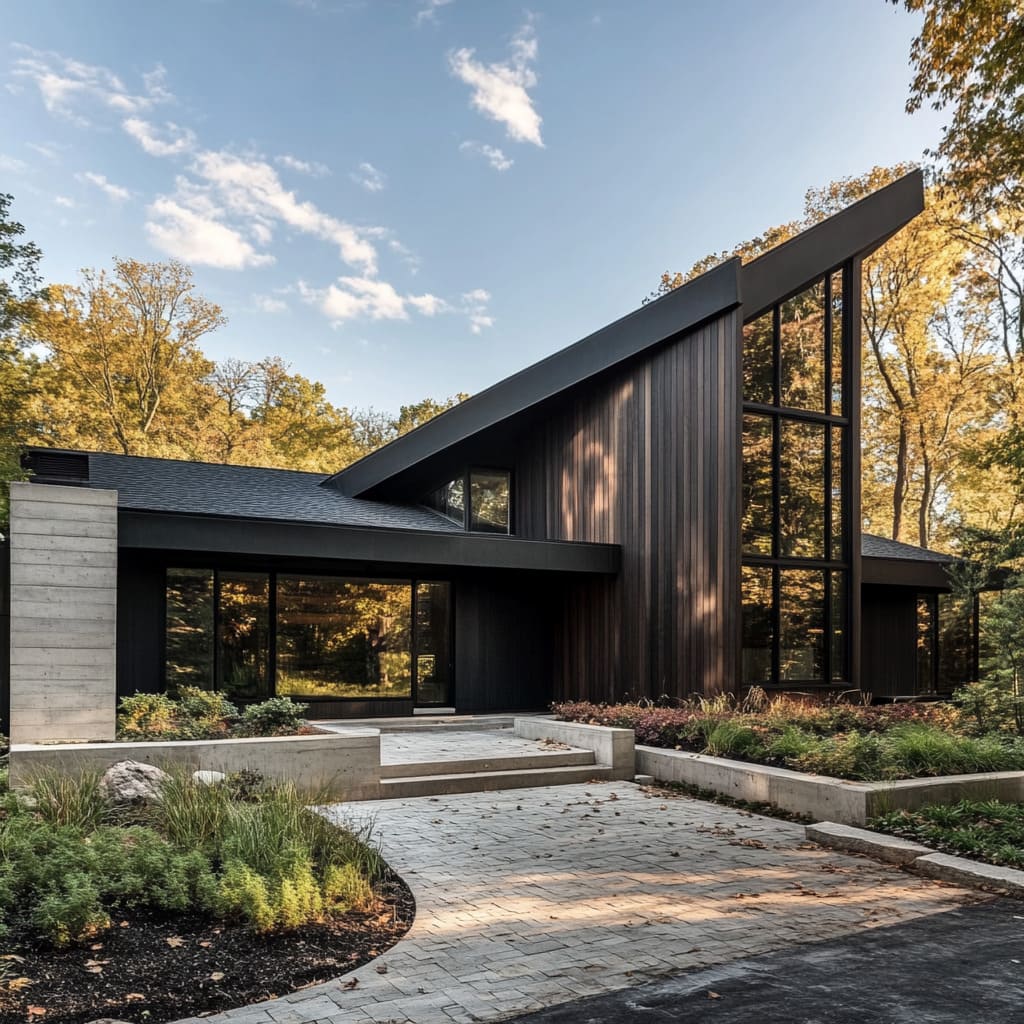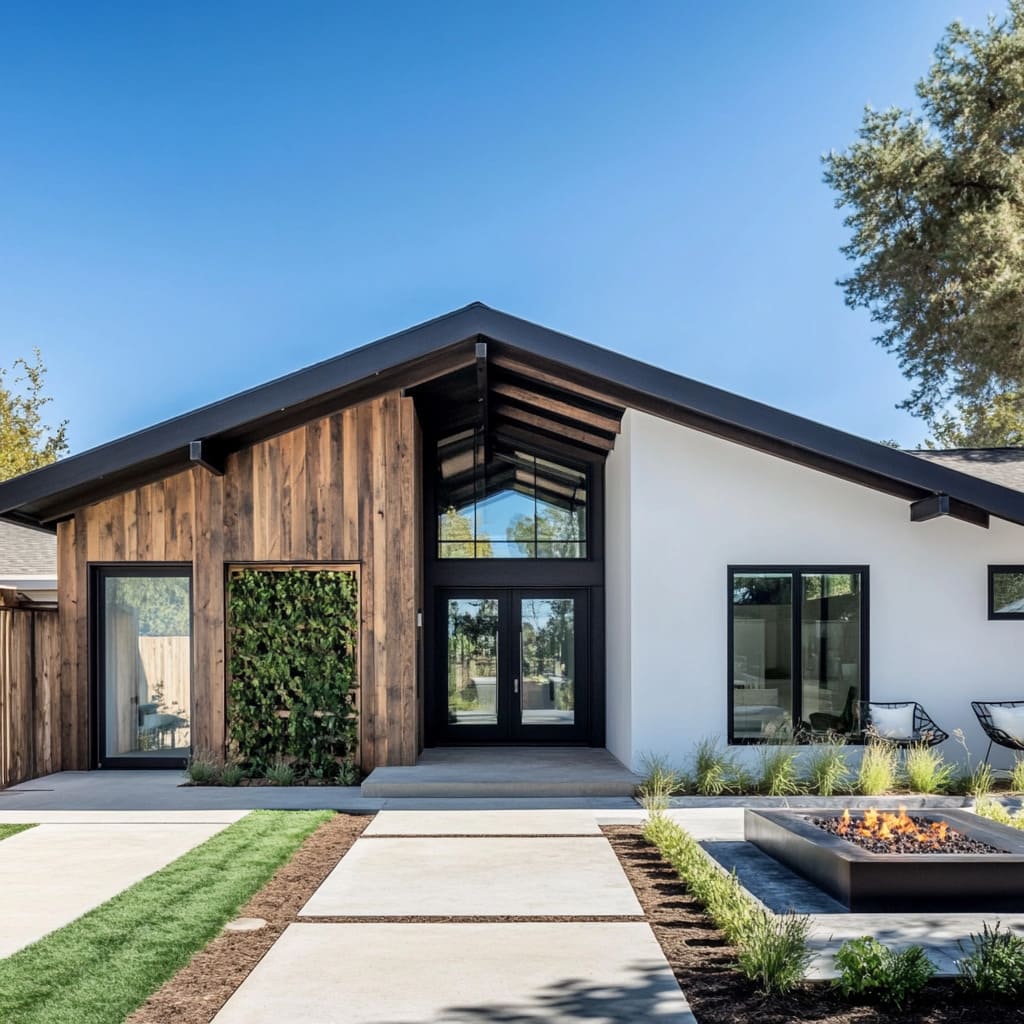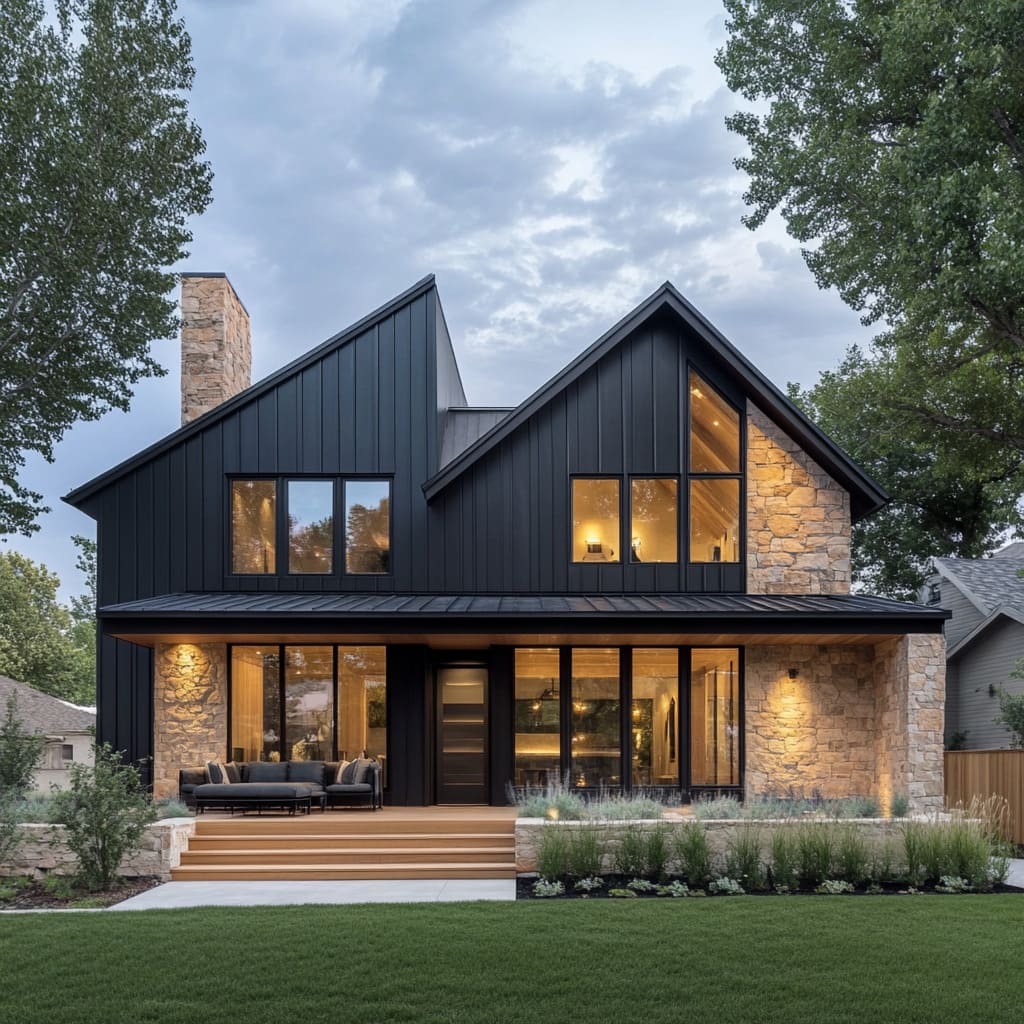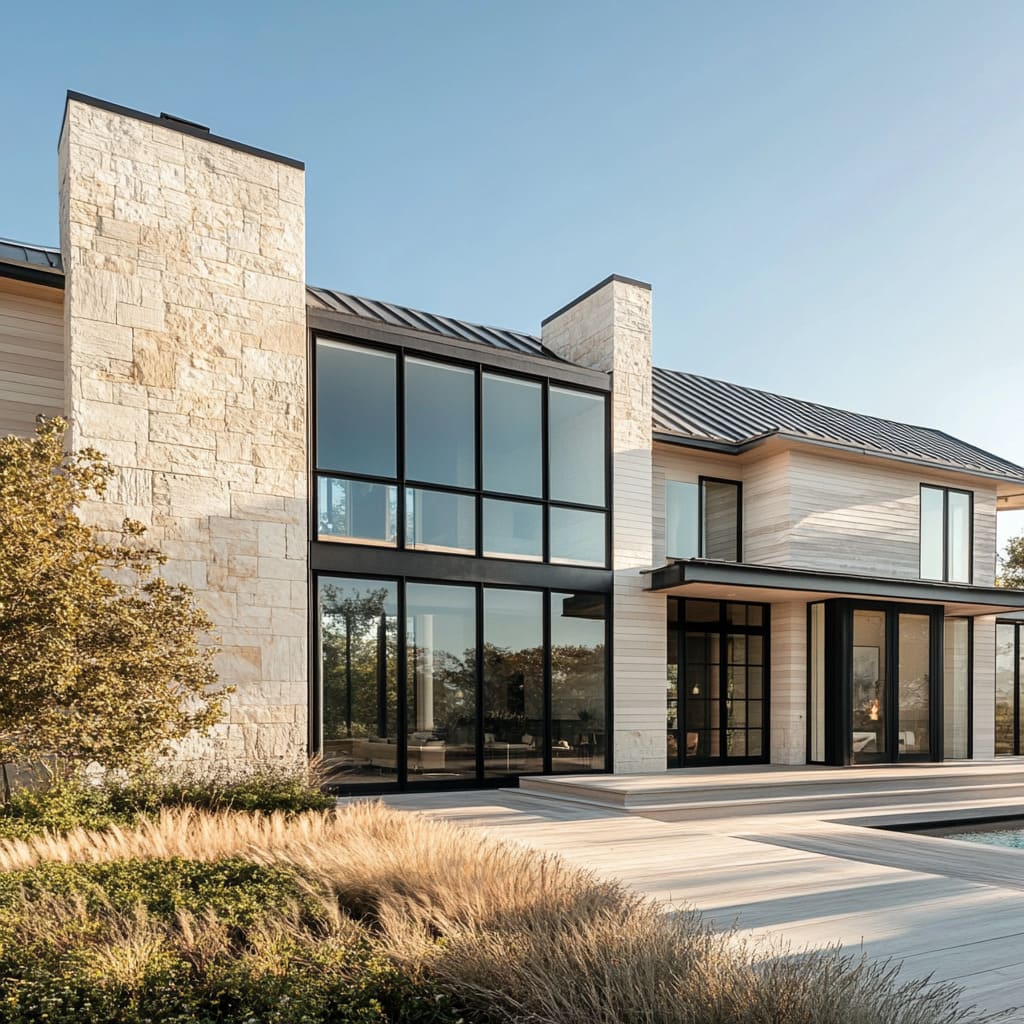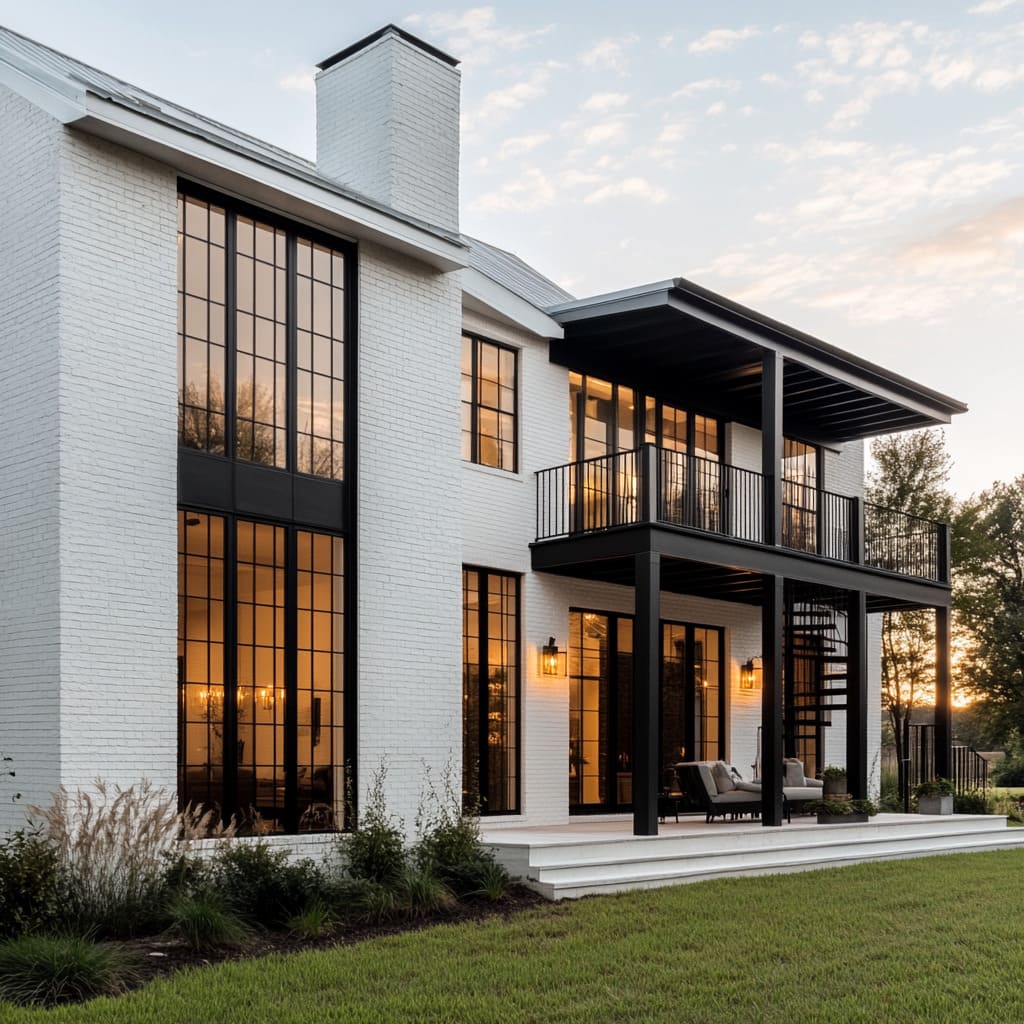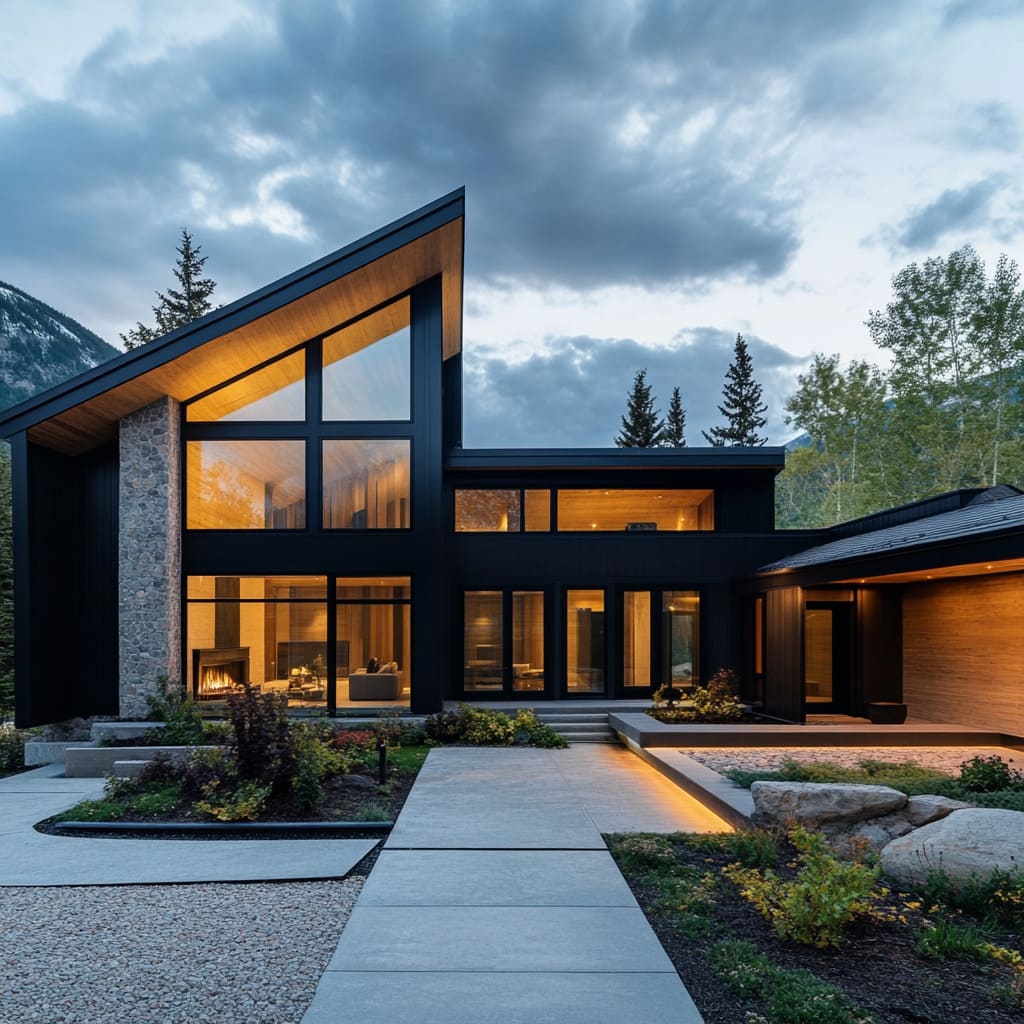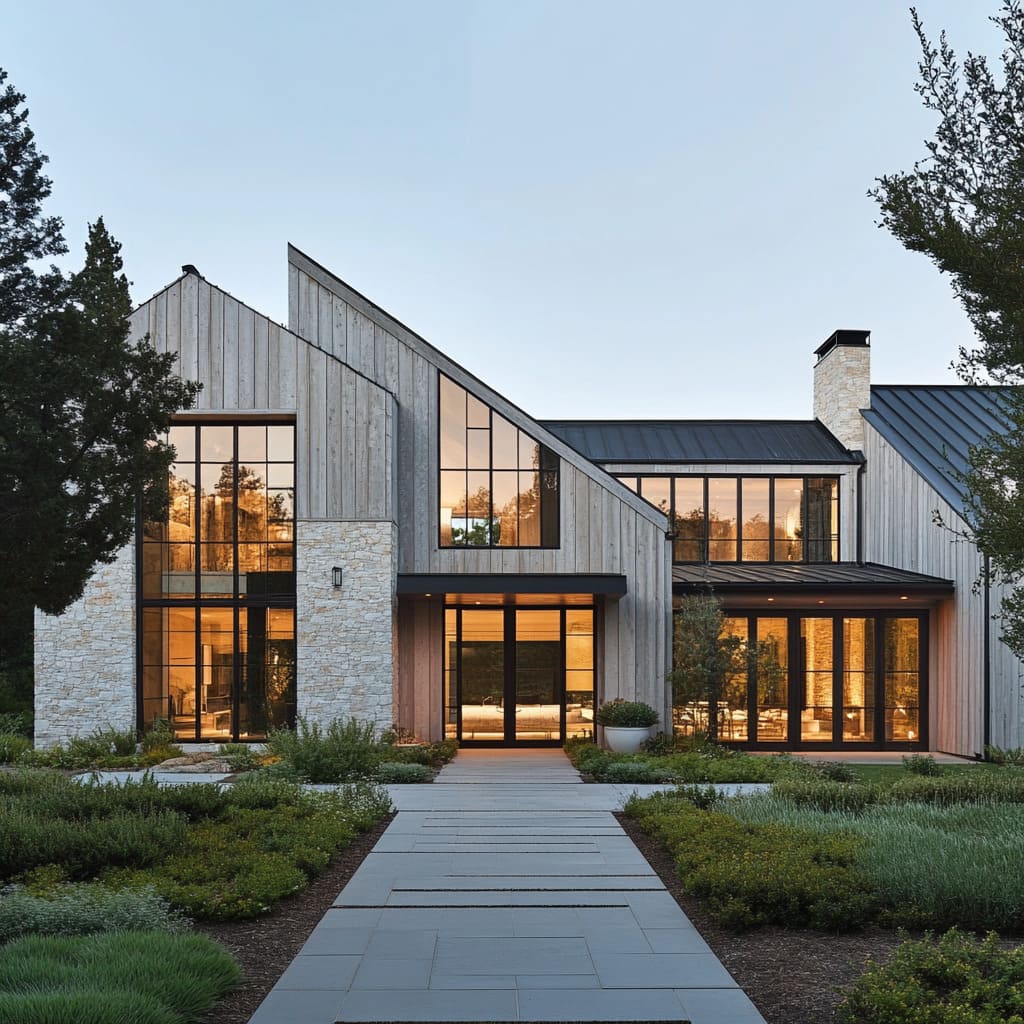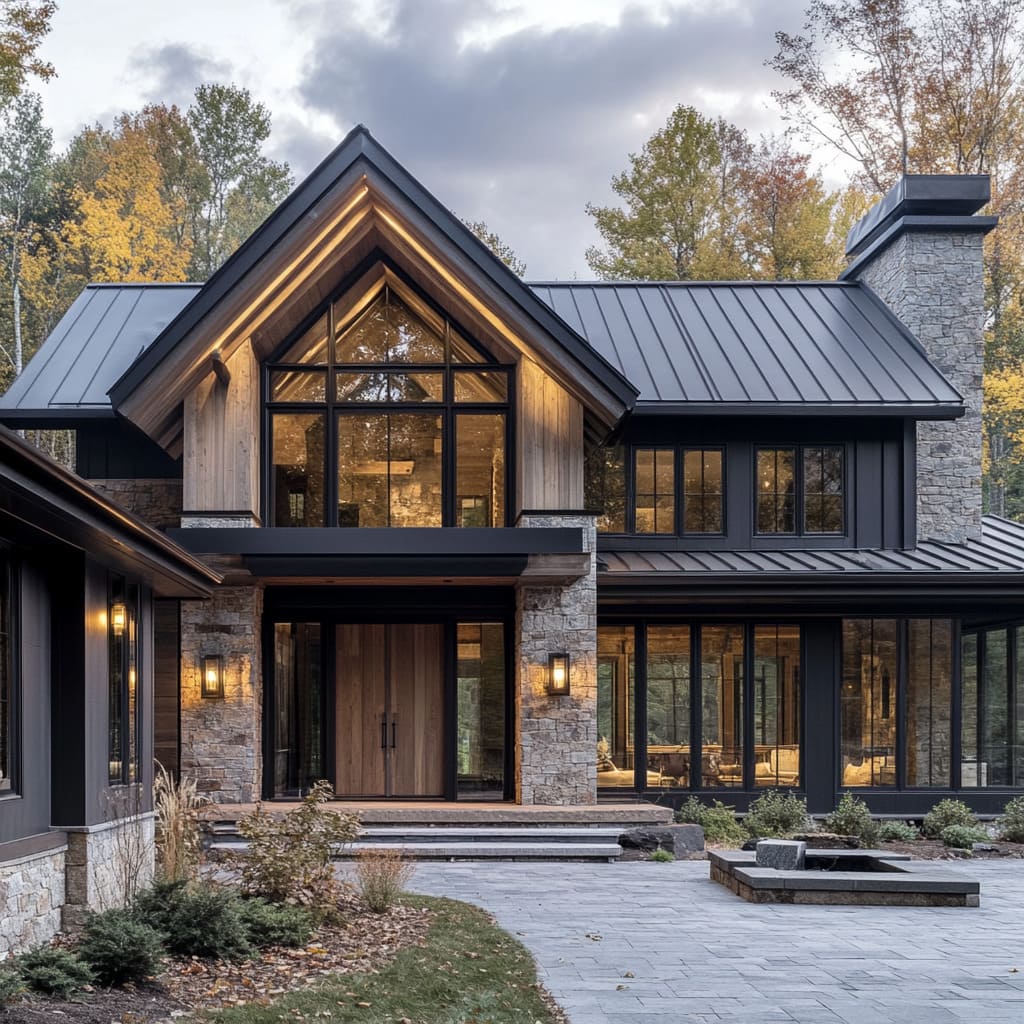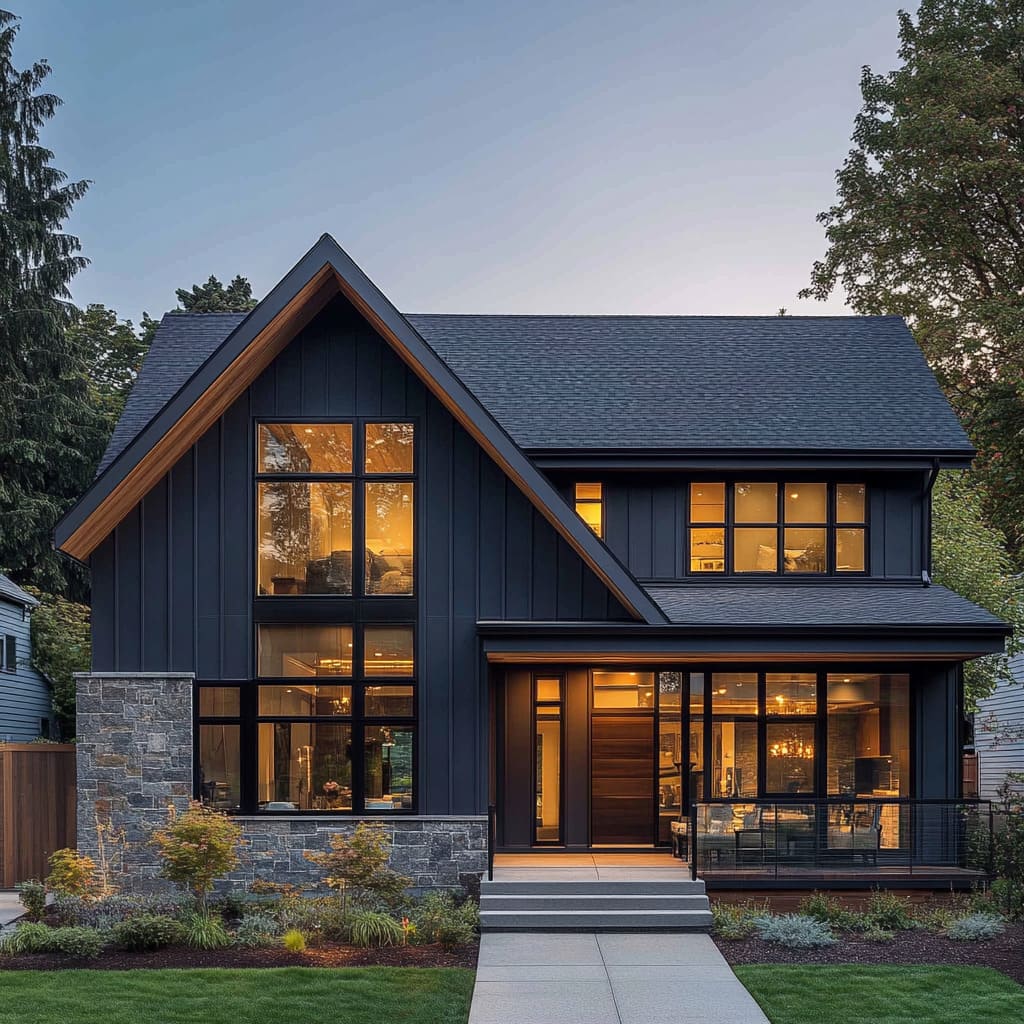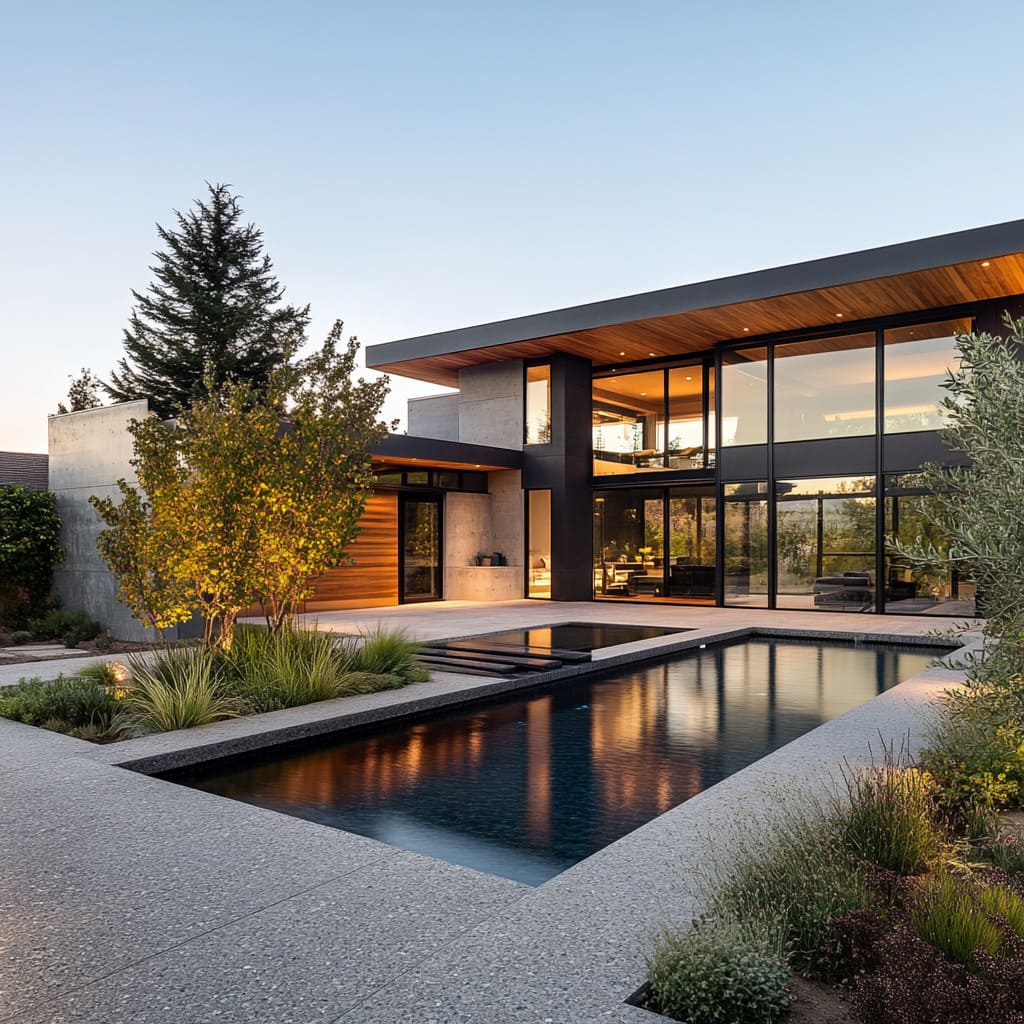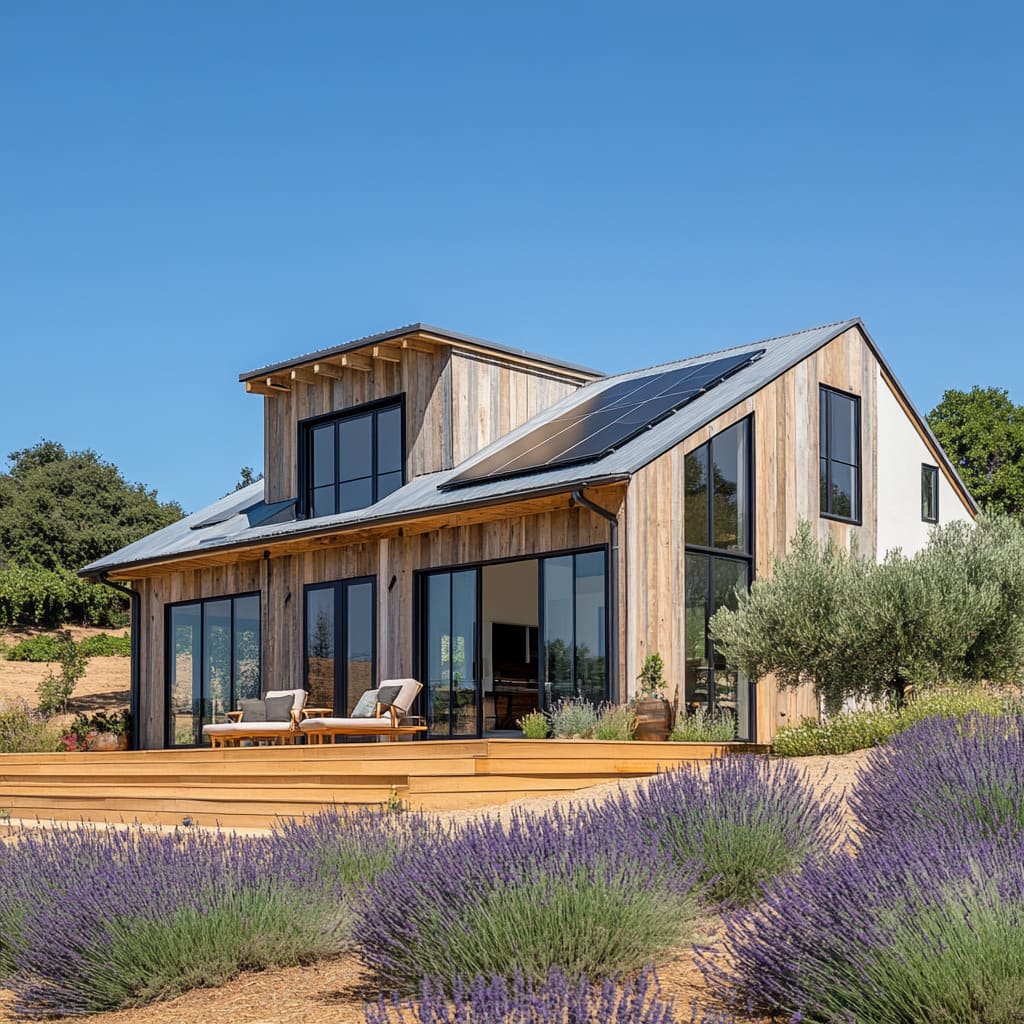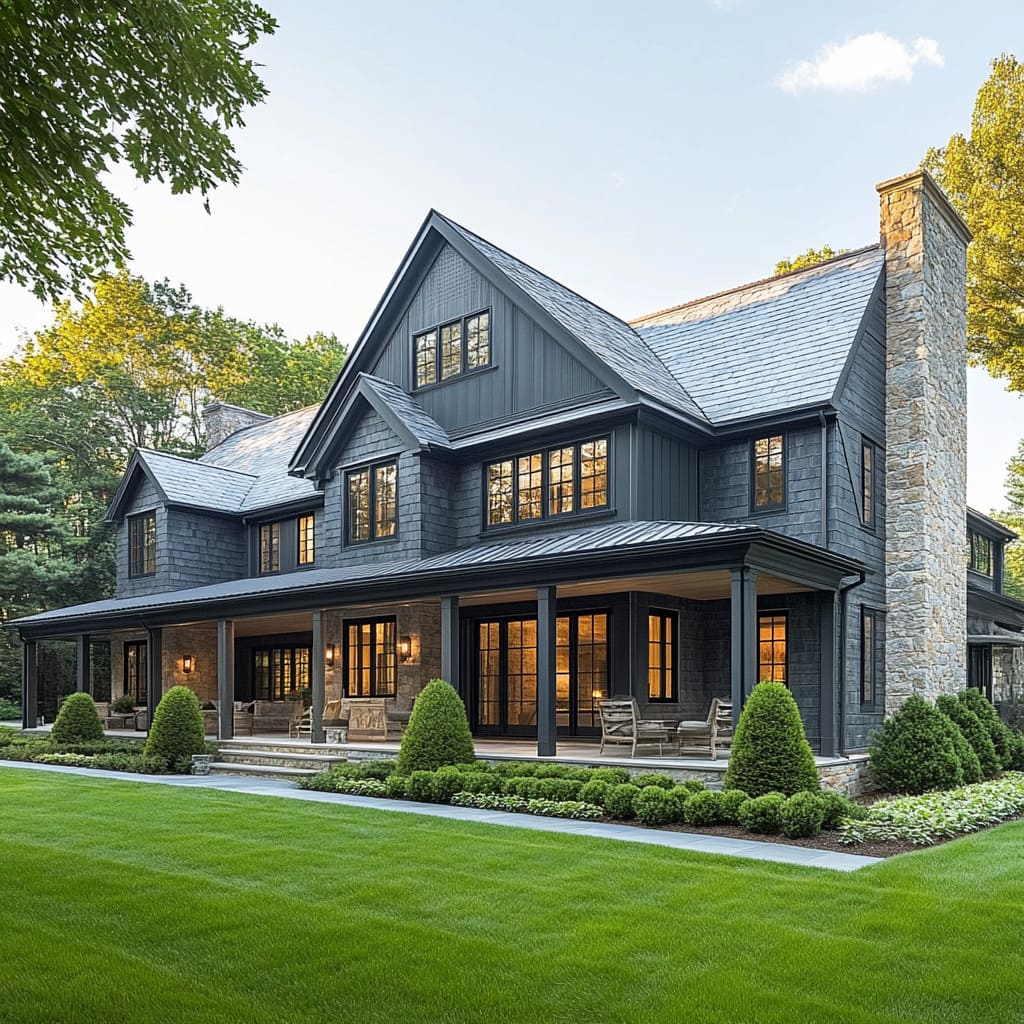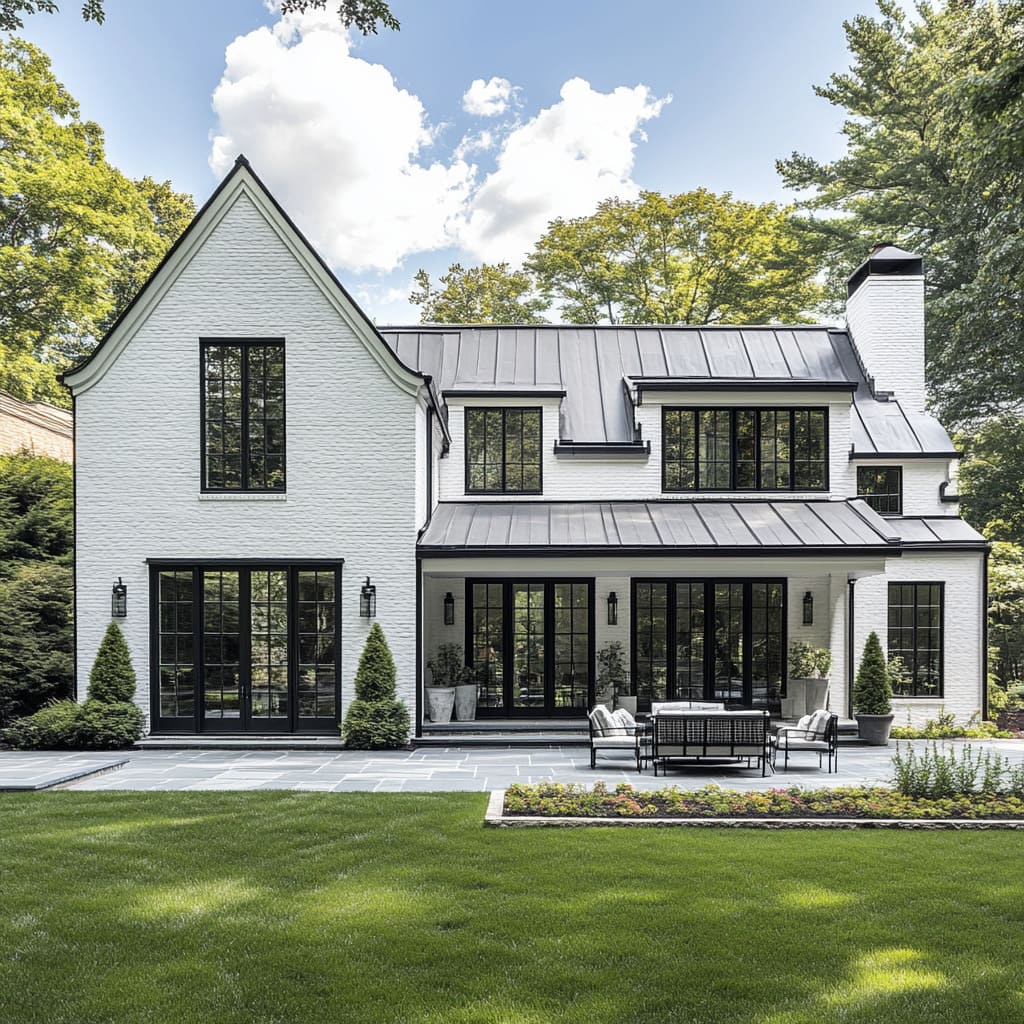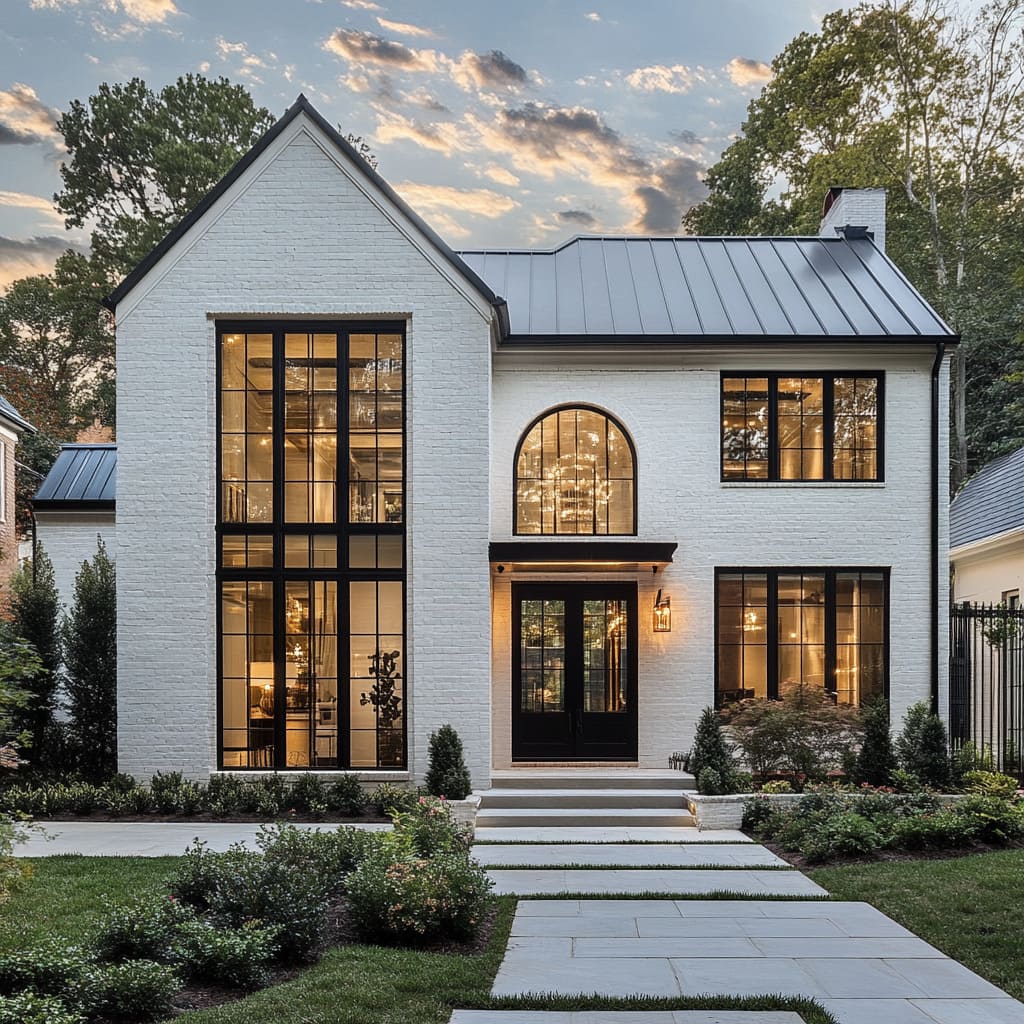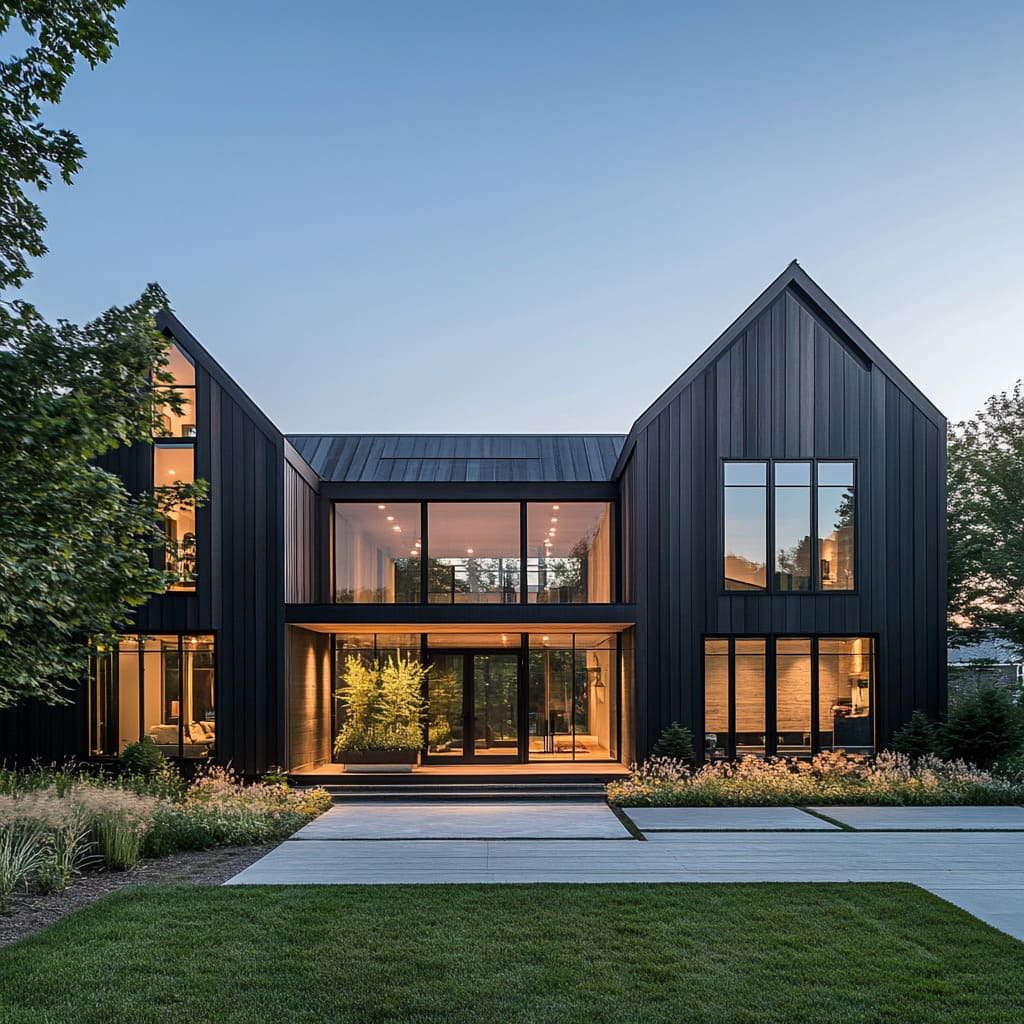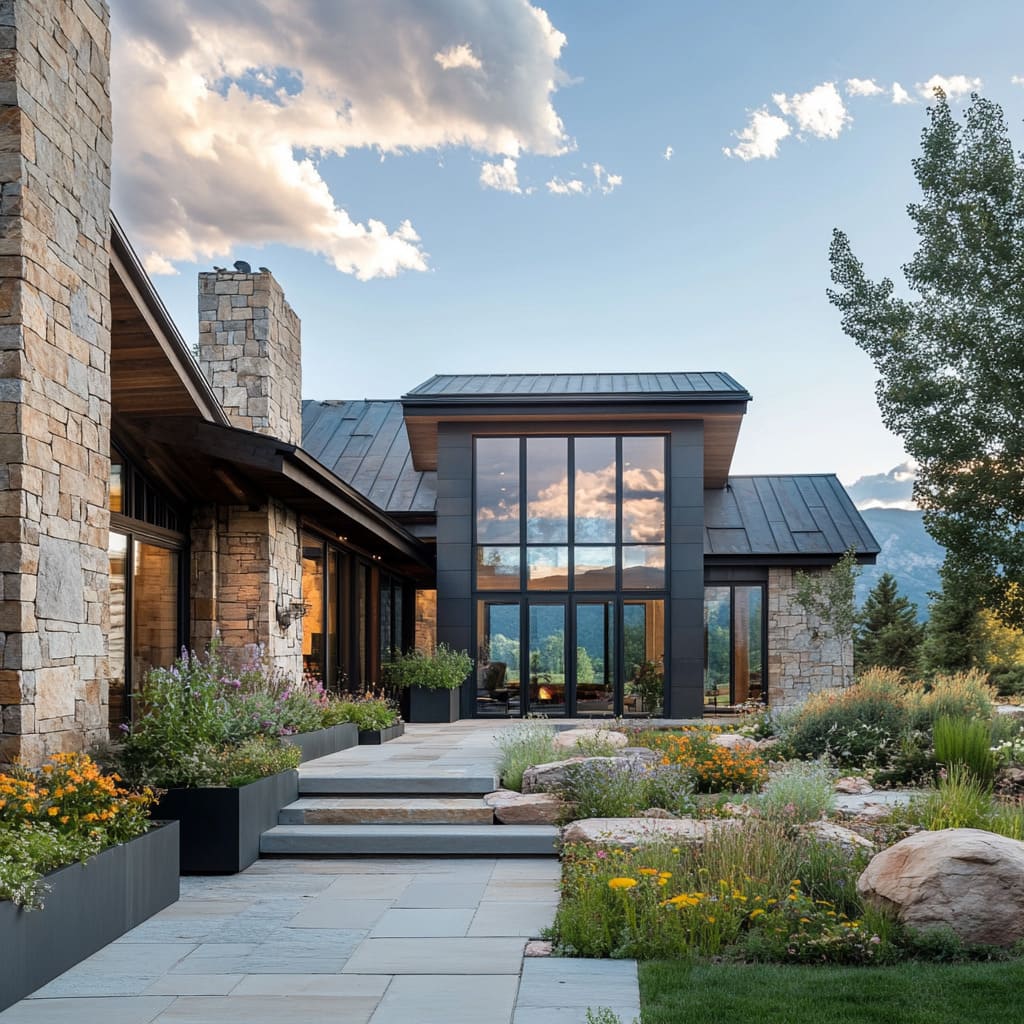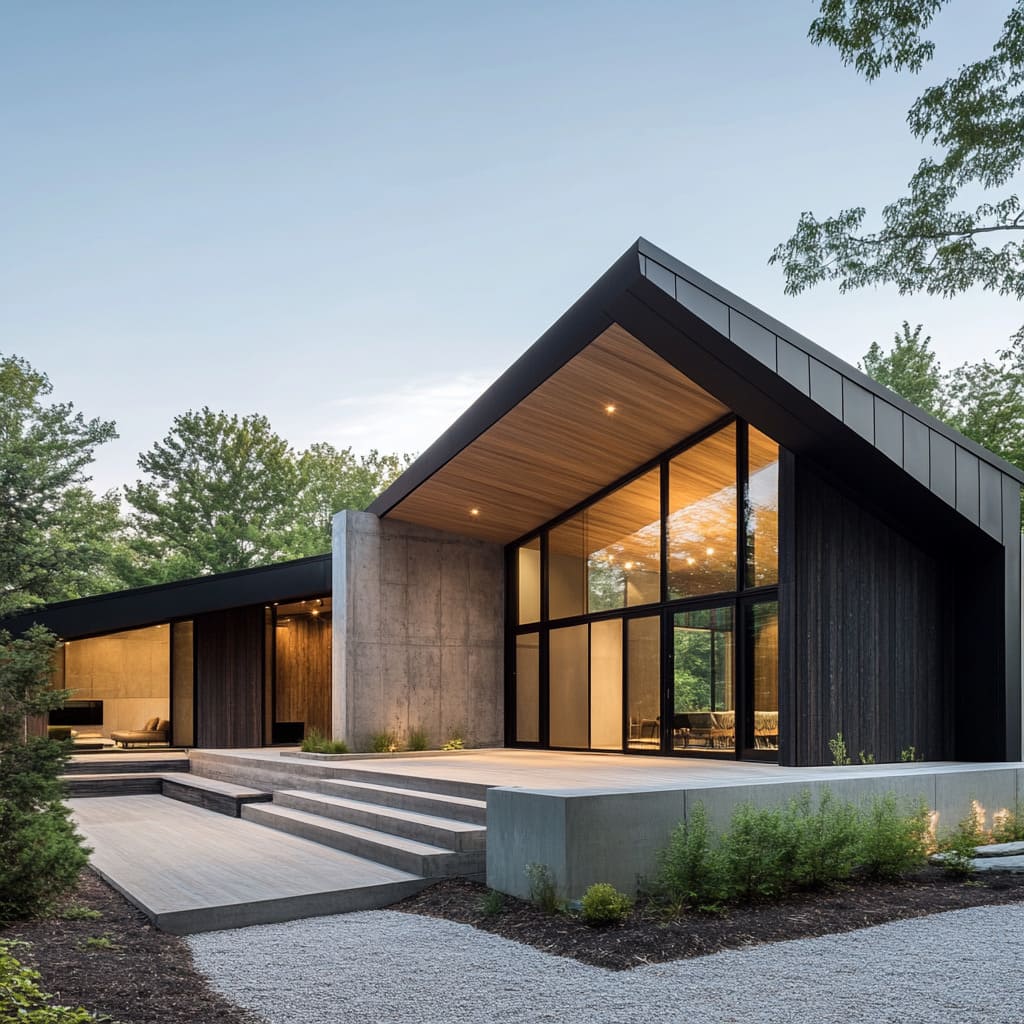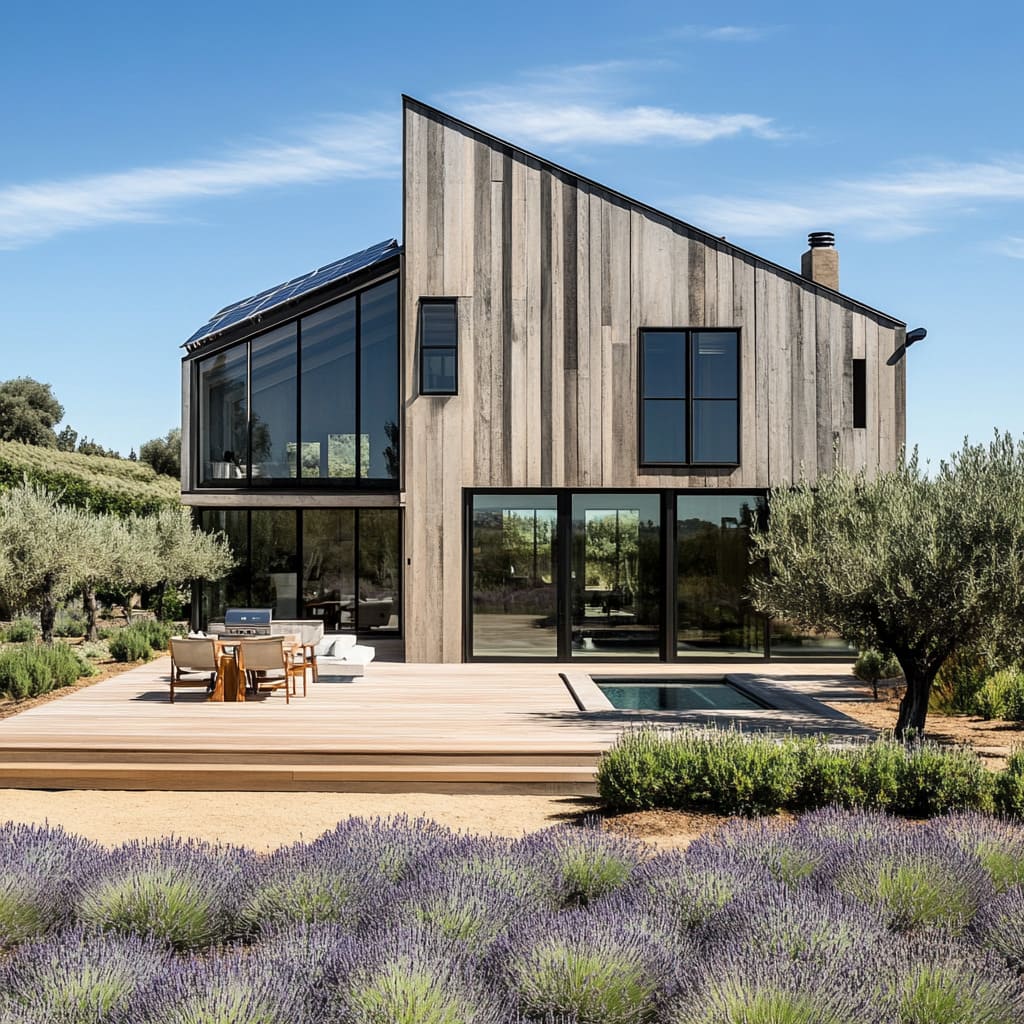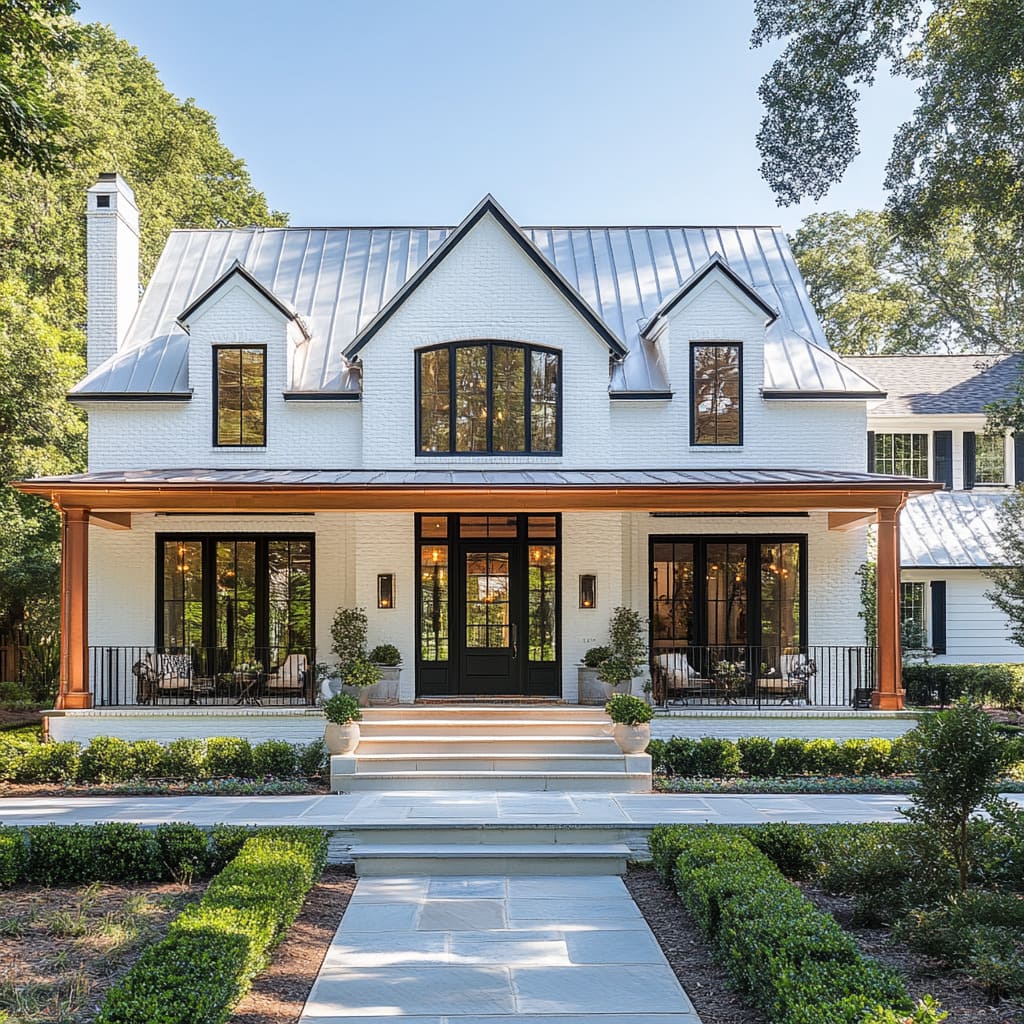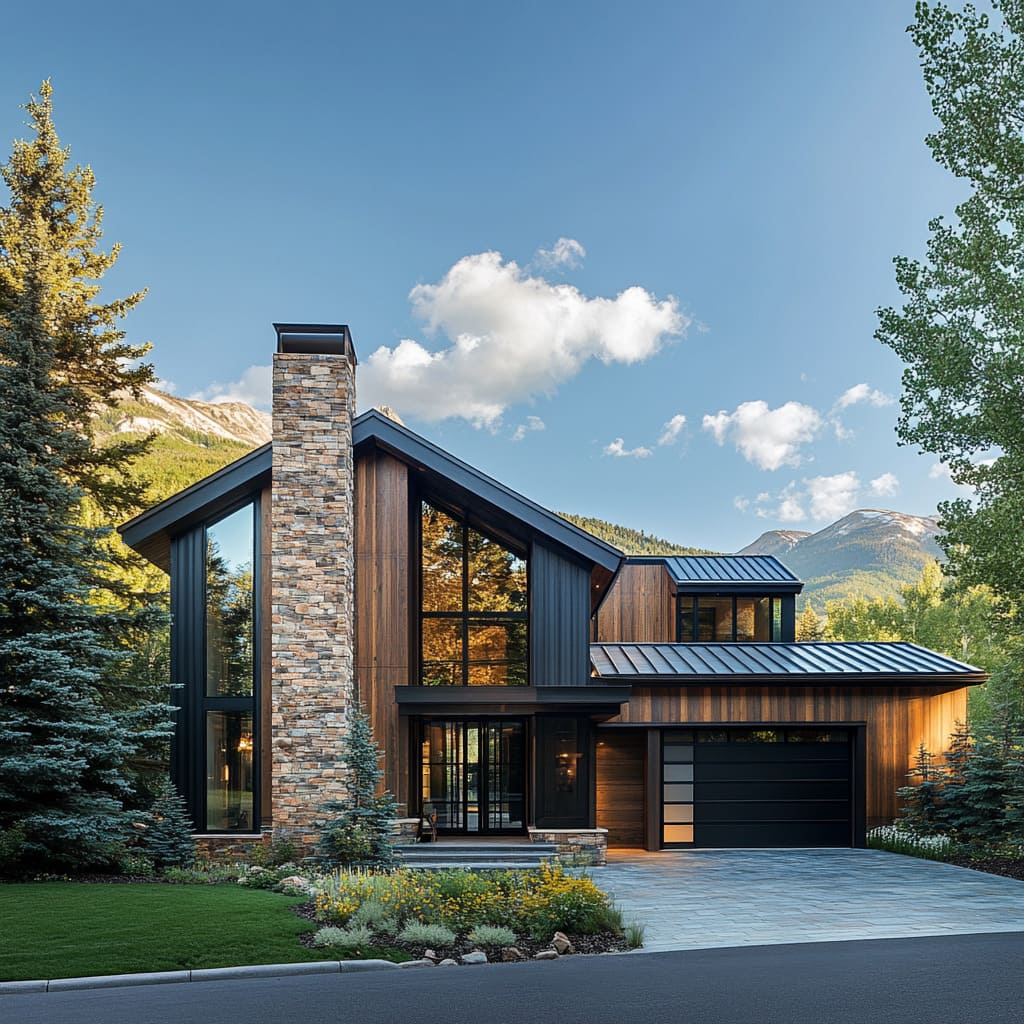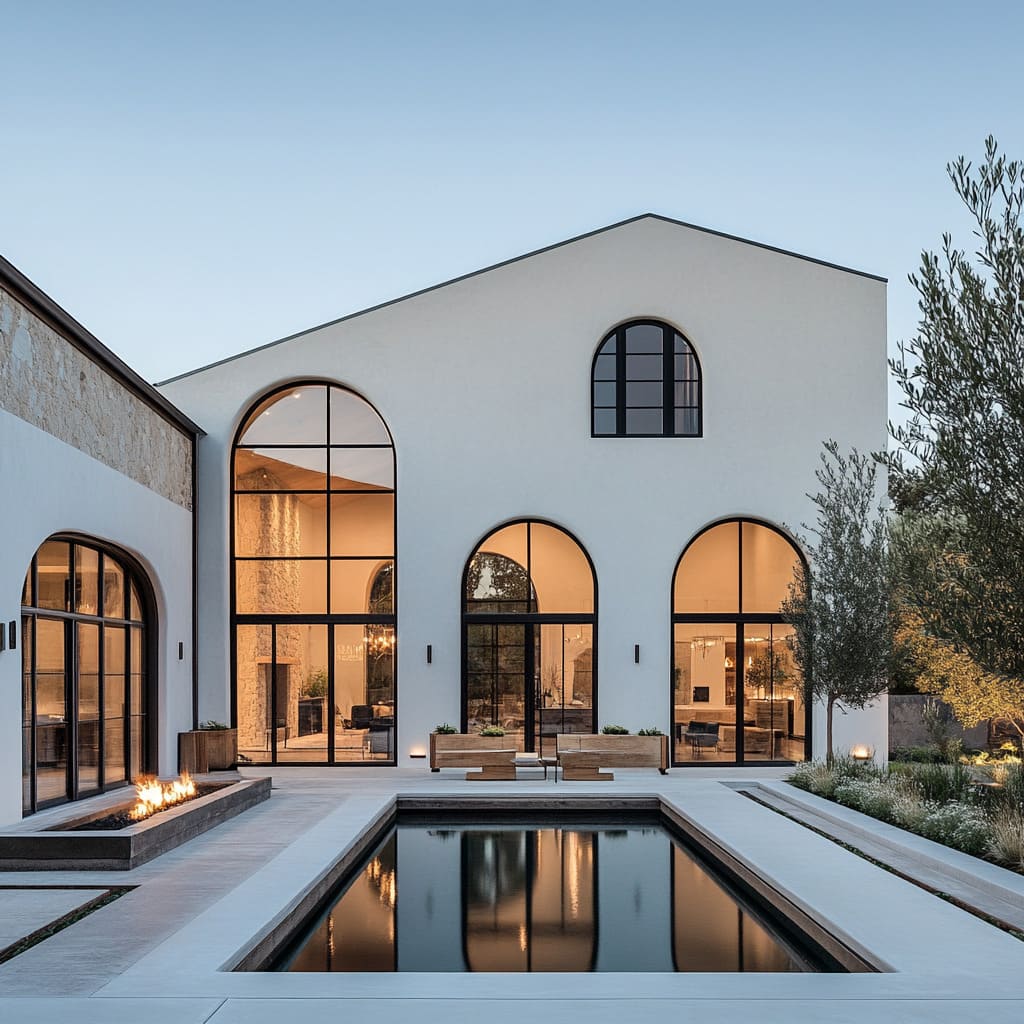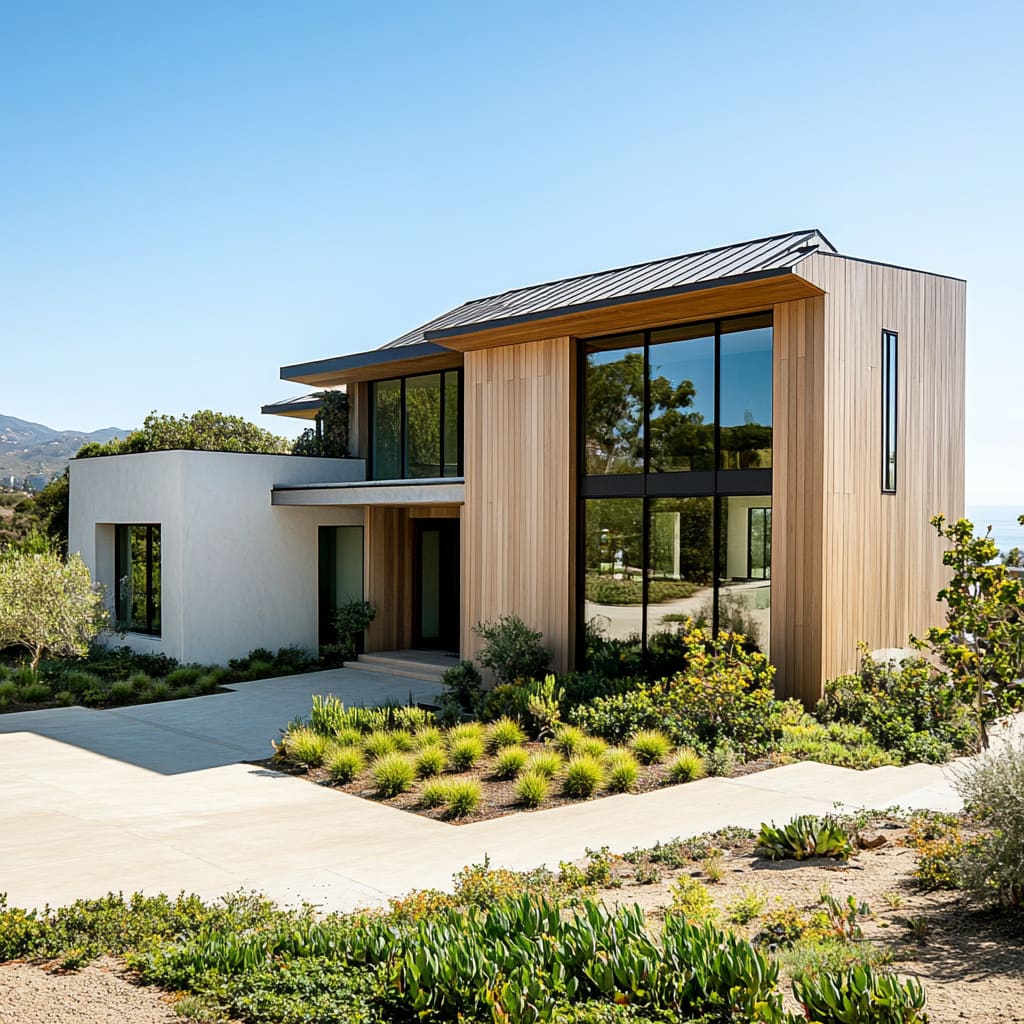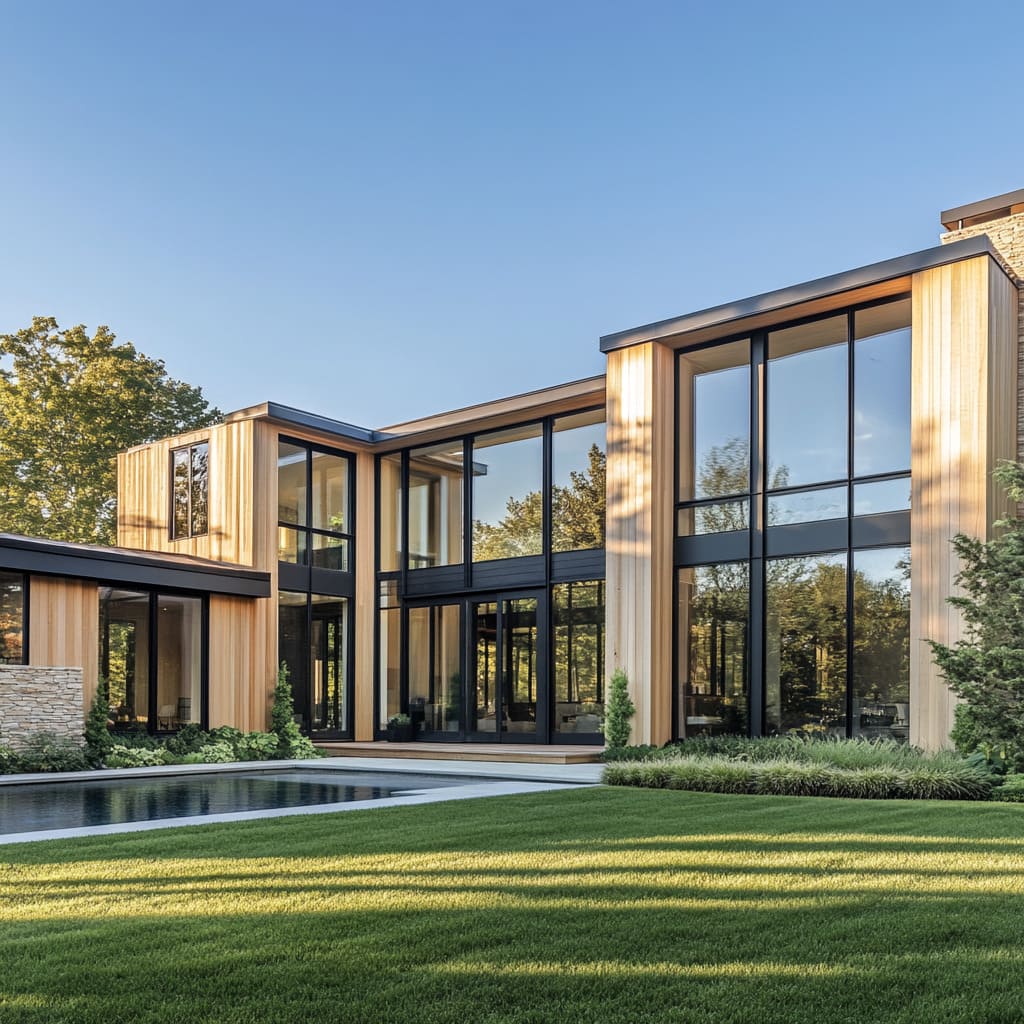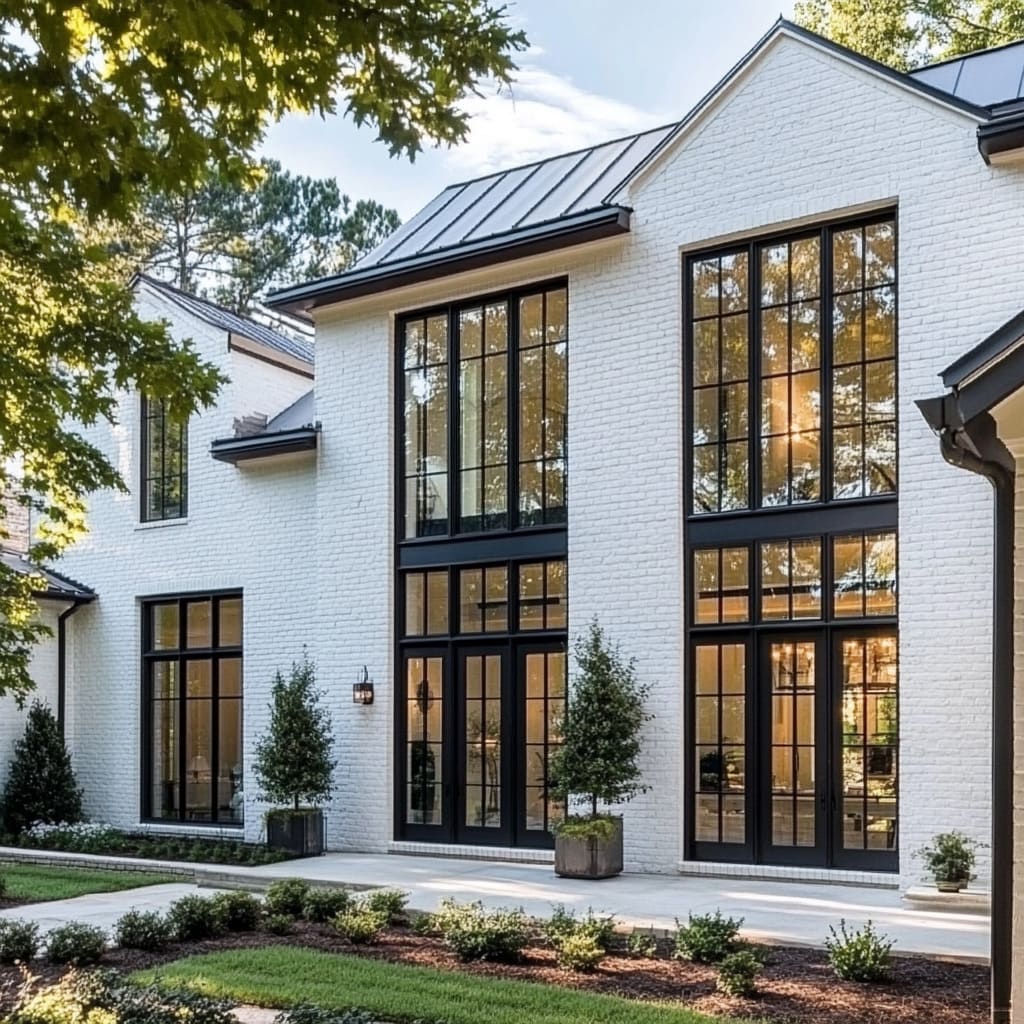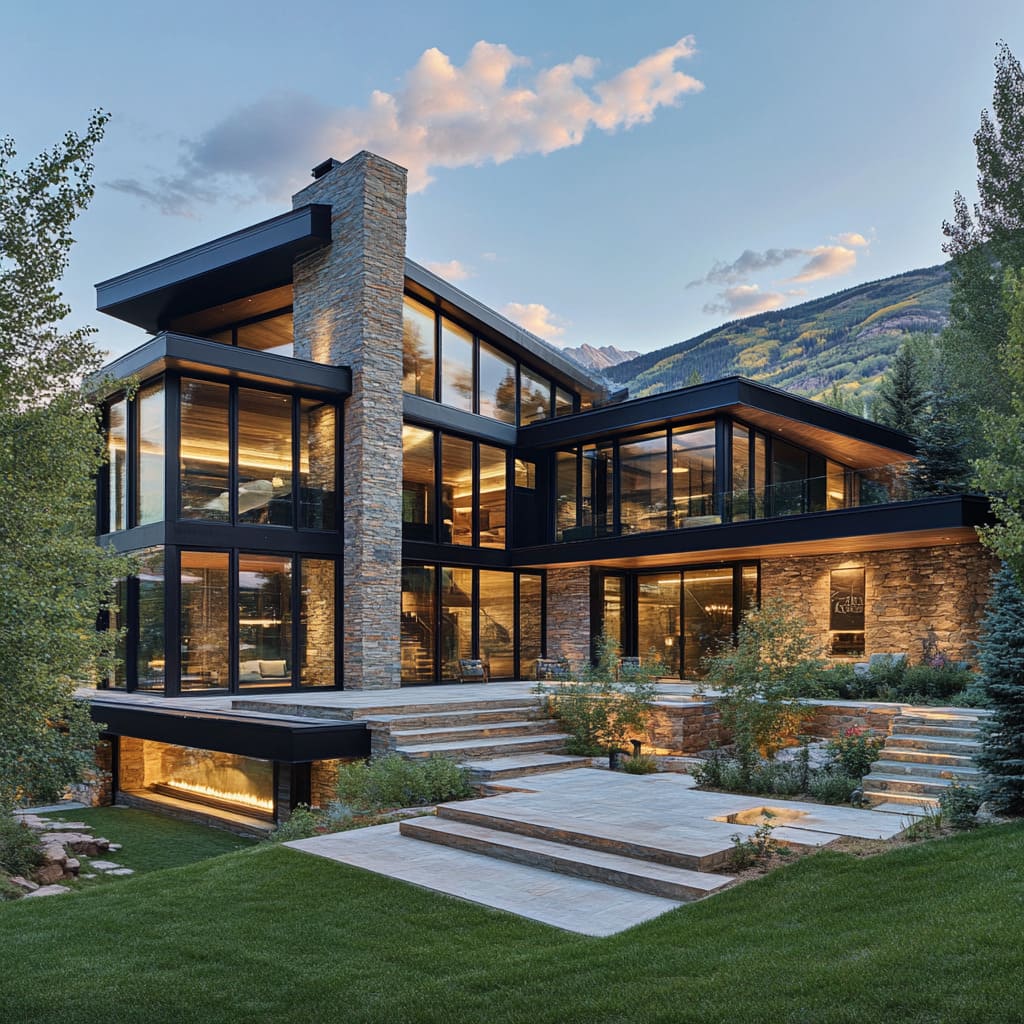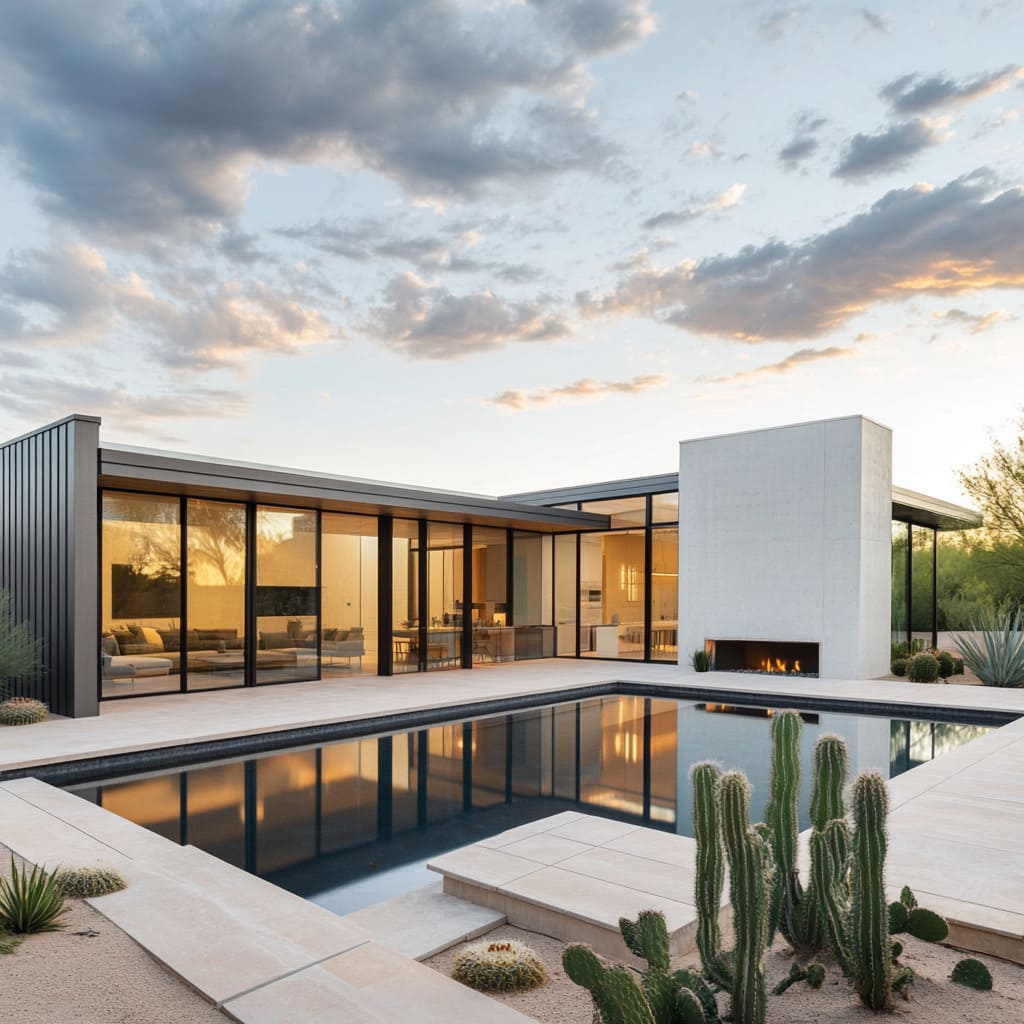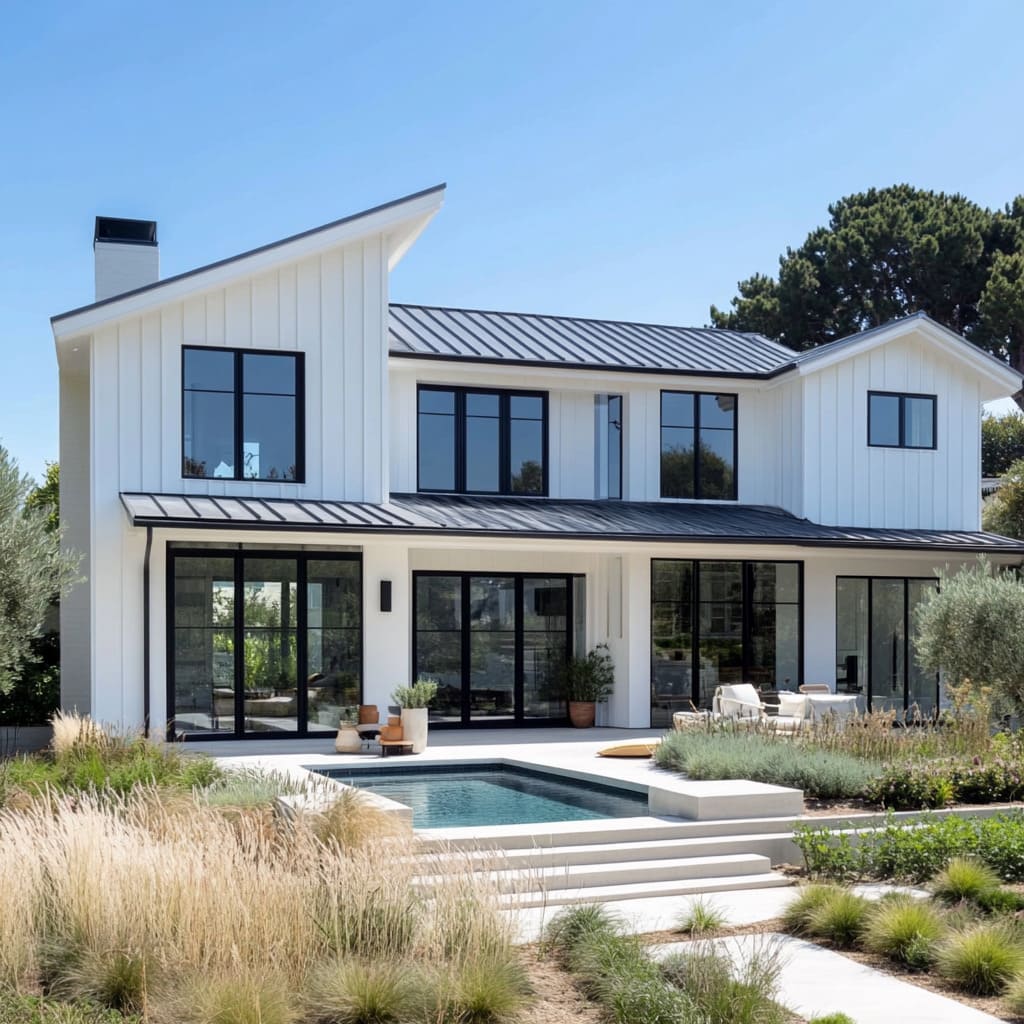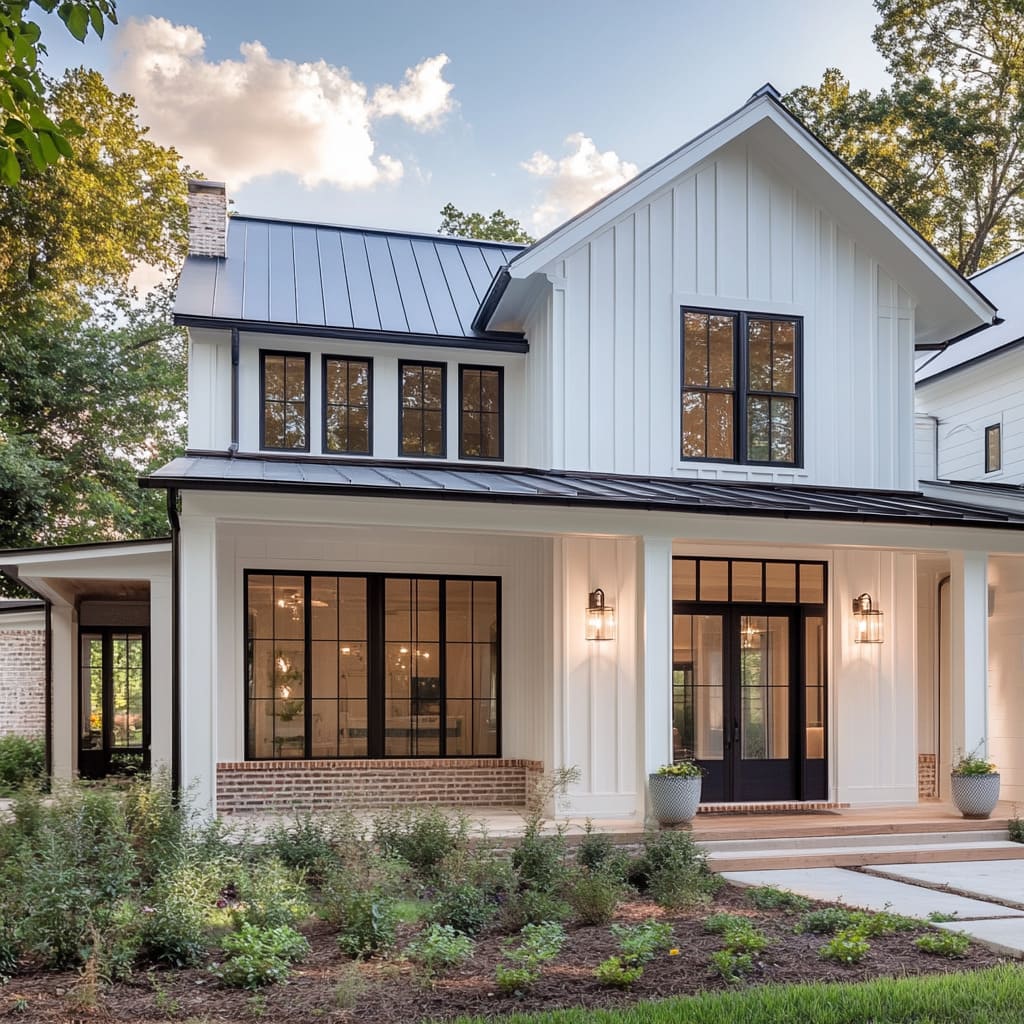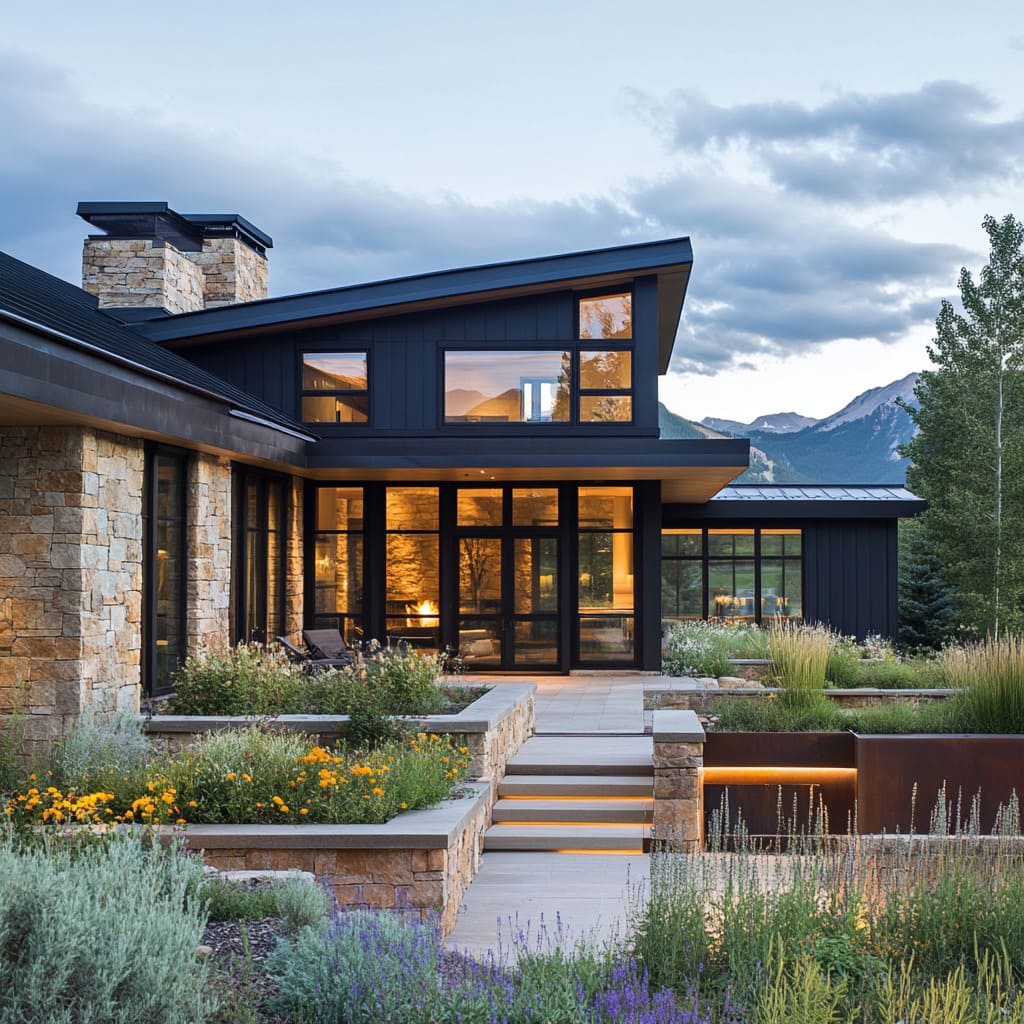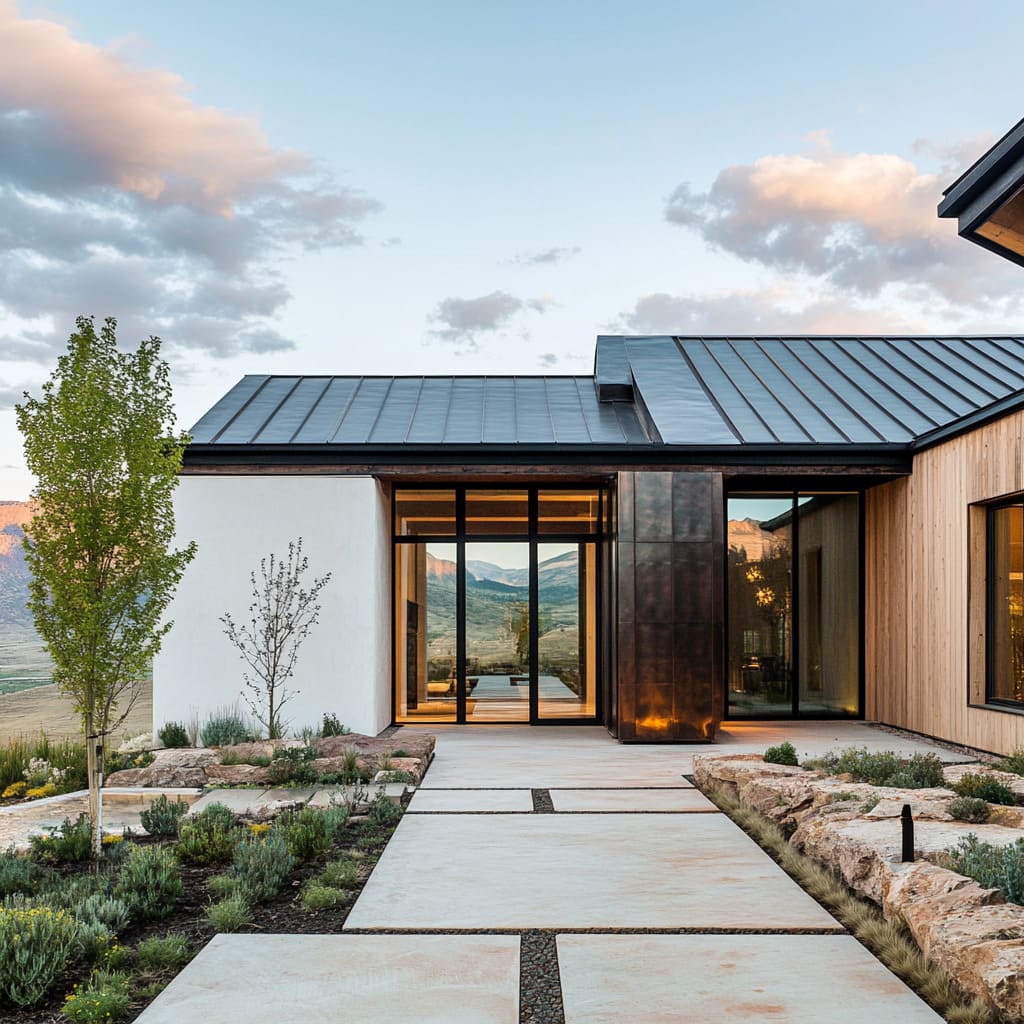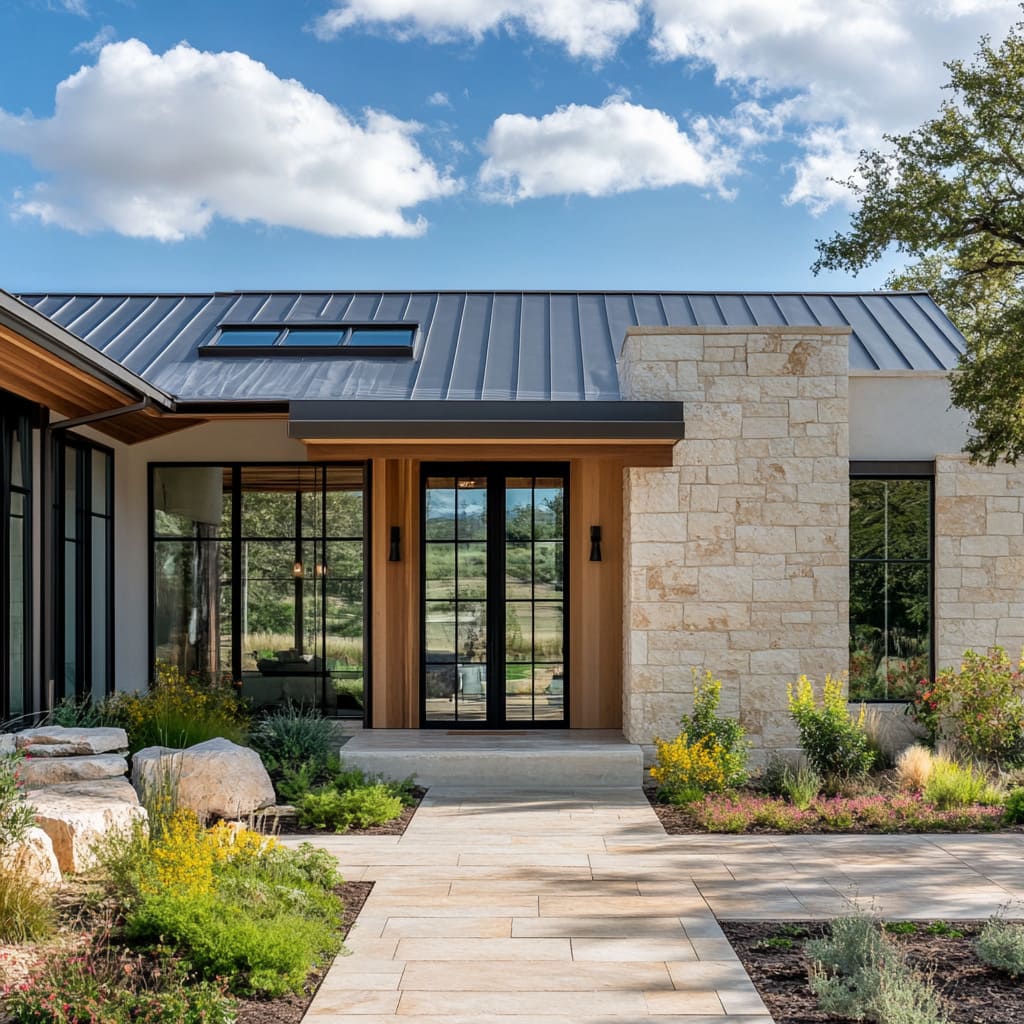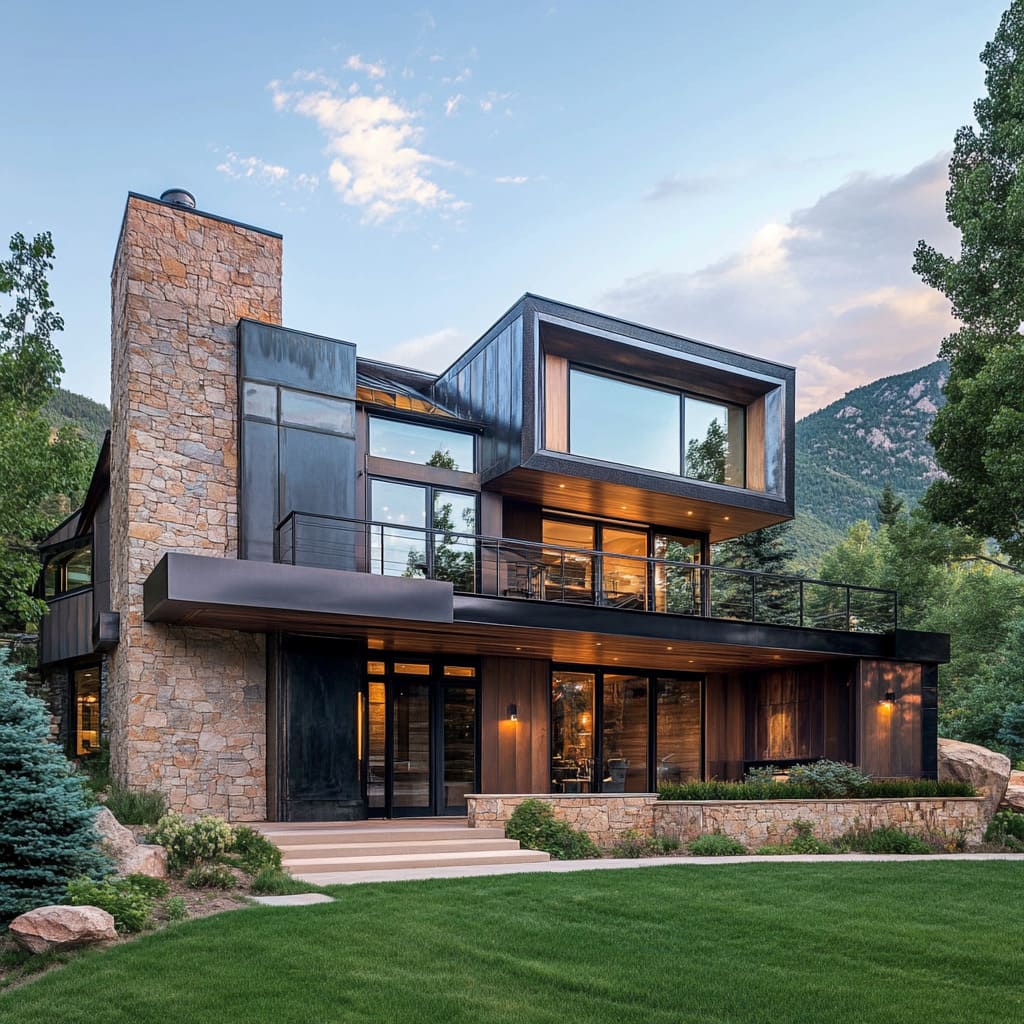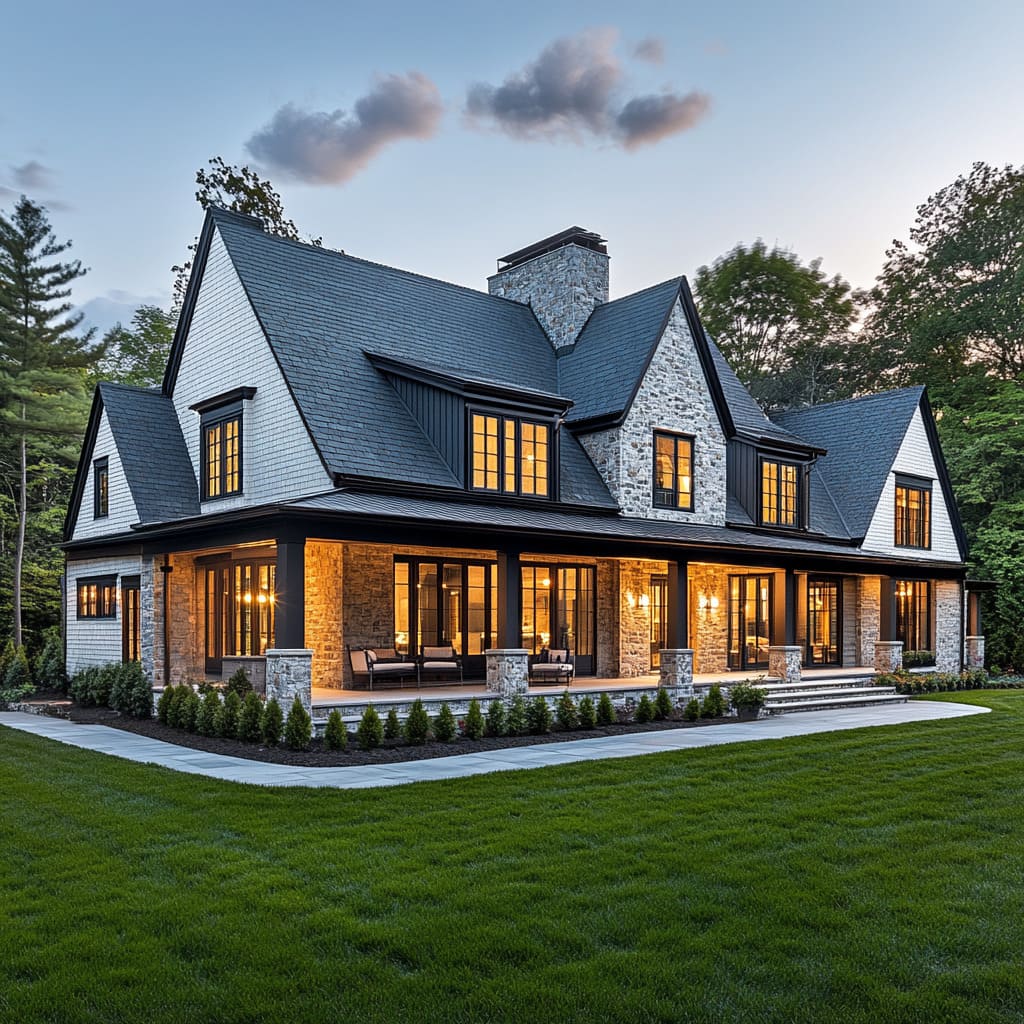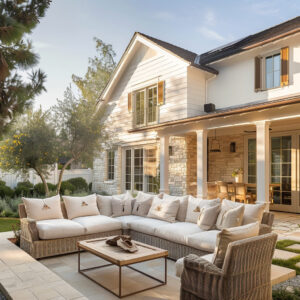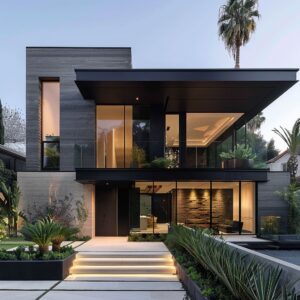Modern farmhouse architecture seamlessly blends the rustic charm of traditional farmhouses with the clean lines and sleek aesthetics of contemporary design. This style has gained popularity in recent years as it offers the perfect balance between old-world warmth and modern sophistication.
By reinterpreting classic farmhouse elements within a contemporary framework, modern farmhouse architecture has become a favorite in modern housing design, appealing to those who appreciate both tradition and innovation
Traditional farmhouse features, such as steeply pitched roofs, gabled forms, and the use of natural materials like wood and stone, are central to this design approach. These elements are reimagined with modern lines and updated forms to create a look that is both familiar and fresh.
The result is a modern style house design that feels comfortable and welcoming, yet stylish and up-to-date. This style embraces simplicity and functionality while incorporating the textures and materials that connect the home to its surroundings
The integration of rustic and contemporary elements is what defines modern farmhouse architecture. This approach combines organic textures, such as wood and stone, with sleek surfaces like metal and glass, creating a visual and tactile contrast that is pleasing to the eye.
Neutral color palettes, often featuring white, gray, and natural wood tones, are commonly used to maintain a calm and cohesive appearance. The careful balance of these elements ensures that the design remains timeless, with a nod to the past while fully embracing the present
Architectural Overview
Key Architectural Elements
Traditional farmhouse architecture is known for its steeply pitched roofs, gabled forms, and simple, functional layouts. These elements are foundational to modern farmhouse design, but they are updated and refined to fit within the context of modern house architecture.
Steeply pitched roofs, for example, are maintained for their classic look and practicality, but they are often executed with cleaner lines and minimal overhangs to create a more streamlined appearance
Gabled forms are another key feature that is retained and modernized. In traditional farmhouses, gables are used to create a sense of height and to protect against the elements.
In contemporary residential architecture, these gabled forms are reinterpreted with a focus on symmetry and proportion, often combined with expansive glass windows that open up the interior to natural light and surrounding views. The result is a structure that is both aesthetically pleasing and functional, maintaining the character of a farmhouse while incorporating the innovations of modern design
Integration with the Environment
A critical aspect of modern farmhouse architecture is how the design integrates with its environment. Traditional farmhouses were often built with a deep connection to the land, and this principle carries through in modern interpretations.
The house is designed to blend with its natural surroundings, using materials and forms that complement the landscape rather than compete with it
Modern farmhouse designs take full advantage of their settings, with large windows and open layouts that frame views of the landscape, bringing the outside in. For example, a modern farmhouse exterior might include floor-to-ceiling windows that offer panoramic views of the surrounding fields or mountains, creating a seamless connection between the home and its environment.
Additionally, the use of natural materials like wood and stone helps the structure feel grounded and part of the landscape, rather than an imposition on it
Facade and Exterior Materials
Material Selection
The selection of materials is one of the most important aspects of modern farmhouse design. Natural stone, wood, metal, and glass are commonly used, each bringing its unique qualities to the overall aesthetic.
Natural stone is often used for its durability and the sense of permanence it imparts. It adds texture and warmth, grounding the design and connecting it to the earth.
Wood is another essential material, providing a connection to the farmhouse’s rural roots. In modern farmhouse architecture, wood is often used in its natural form or with a weathered finish to add character without overwhelming the design.
The warmth of wood balances the cooler tones of metal and glass, ensuring the home feels inviting rather than stark
Metal, typically used for roofing and window frames, adds a contemporary edge to the design. The sleekness of metal contrasts with the rough textures of stone and wood, creating a dynamic visual balance.
Glass is used extensively to maximize natural light and to open up the interior to the exterior, reinforcing the connection between the home and its environment. The combination of these materials creates a facade that is both visually interesting and deeply connected to its setting
Color Palette
The color palette of a modern farmhouse is usually understated, with a focus on neutral and earthy tones. Whites, grays, and natural wood colors dominate, creating a sense of calm and continuity throughout the design.
These colors are chosen not only for their aesthetic appeal but also for their ability to highlight the natural materials used in the construction
A common approach is to use white or light-colored stucco or siding for the main body of the house, which provides a clean backdrop that allows other elements to stand out. This is often contrasted with darker tones in the window frames, roofing, or trim, adding depth and definition to the overall look.
For instance, a modern farmhouse might feature a white stucco exterior with black metal window frames, creating a sharp, contemporary contrast that highlights the clean lines of the design
The use of natural wood tones adds warmth to the color palette, ensuring the home feels inviting and connected to nature. The contrast between light and dark elements, as well as between organic and sleek surfaces, is what gives modern farmhouse design its distinctive character.
This approach to color and materials ensures that the home feels both timeless and contemporary, with a design that is both functional and beautiful. By thoughtfully blending these elements, modern farmhouse architecture creates homes that are both rooted in tradition and forward-thinking, offering a perfect blend of past and present in modern housing design
Roof Design and Architectural Features
Roof Forms
The roof is one of the most defining features in both traditional and modern farmhouse architecture. The steeply pitched gable roof, a hallmark of farmhouse design, serves not only a practical purpose but also adds to the aesthetic appeal of the structure.
Traditionally, these roofs were designed with steep angles to efficiently shed snow and rain, a necessity in rural settings. In modern craftsman style houses, this feature is preserved for its visual impact and historical significance, but it’s reinterpreted with contemporary lines and materials that align with today’s architectural trends
In contemporary home design, the steep pitch of the gable roof is often emphasized with clean, straight lines that create a sharp, modern profile. This design choice allows the roof to make a bold statement, while still honoring its traditional roots.
The materials used in these roofs vary, but two of the most popular choices are terracotta tiles and metal panels. Terracotta tiles, often associated with Mediterranean architecture, bring warmth and texture to the roof.
They are durable, weather-resistant, and maintain their color over time, making them an excellent choice for those looking to combine tradition with longevity
Metal panels, on the other hand, offer a sleek and modern alternative. They are lightweight, durable, and available in a range of colors and finishes, allowing for greater flexibility in design.
Metal roofs are also highly reflective, which can help in regulating the home’s temperature by reflecting the sun’s rays rather than absorbing them. This makes them a practical choice for farmhouse exteriors, where functionality and aesthetics are equally important
Modern Enhancements
While the steeply pitched gable remains a dominant feature, contemporary modern houses often incorporate additional elements into the roof design to enhance both aesthetics and functionality. One such enhancement is the inclusion of flat roof sections.
These sections provide a stark contrast to the angled gables and are often used to create outdoor living spaces, such as rooftop terraces or green roofs. Flat roofs add a modern twist to the overall design, creating a layered effect that is visually engaging
Overhangs are another critical element in modern roof design. These extensions of the roofline serve multiple purposes, from providing shade and shelter to enhancing the visual depth of the building.
In modern style homes, overhangs are carefully designed to be both functional and aesthetic, providing protection from the elements while also framing views and creating interesting shadows that change with the time of day. Integrated covered outdoor spaces are also a common feature in modern farmhouse architecture.
These spaces, often located beneath an overhanging roof or within a recessed section of the house, create a seamless connection between indoor and outdoor living areas. They provide sheltered spaces for dining, lounging, or simply enjoying the outdoors, all while maintaining a cohesive aesthetic that ties the entire structure together
The role of roof design in modern farmhouse architecture goes beyond simple shelter. It influences the overall aesthetic of the home, contributing to its character and charm, while also enhancing functionality.
The careful consideration of materials, angles, and additional elements like overhangs and flat sections allows for a design that is both practical and visually compelling, creating a home that stands out in any setting
Windows and Natural Light
Maximizing Natural Light
One of the most significant aspects of contemporary home design is the strategic use of windows to maximize natural light. In modern farmhouse designs, large, floor-to-ceiling windows are a staple, providing an abundance of natural light that floods the interior spaces.
These windows not only illuminate the home but also create a strong visual connection with the surrounding landscape, allowing the beauty of the outdoors to be appreciated from within
The placement of windows is carefully considered to capture the best natural light throughout the day. For example, east-facing windows might be used in bedrooms to capture the morning light, while large west-facing windows can frame stunning sunsets in the living areas.
The size and placement of these windows are crucial, as they help define the character of the interior spaces and ensure that each room benefits from ample natural light. The use of large windows also plays a vital role in energy efficiency.
By allowing more natural light into the home, there is less reliance on artificial lighting during the day, reducing energy consumption. Additionally, modern windows are often double or triple-glazed, providing excellent insulation and helping to maintain a comfortable indoor temperature, regardless of the season
Indoor-Outdoor Connection
The connection between indoor and outdoor spaces is a fundamental principle in modern farmhouse architecture. Glass walls and sliding doors are essential elements that create this seamless transition, blurring the boundaries between the interior and exterior environments.
These features allow for an uninterrupted flow between the living spaces and the outdoor areas, making it easy to move between the two and enjoy the surrounding nature
Glass walls are particularly effective in creating a sense of openness and continuity. They provide expansive views of the landscape, making the home feel larger and more connected to its environment.
Sliding doors enhance this effect by allowing entire sections of the wall to be opened up, merging indoor living areas with outdoor patios or gardens. This design approach not only enhances the aesthetic appeal of the home but also improves the functionality of the living spaces, making them more versatile and adaptable to different needs
In many modern farmhouse designs, the windows and doors are framed in black metal, adding a modern contrast to the traditional materials used in the rest of the home. This choice of framing is both practical and stylish, providing durability while also creating a sharp, clean look that complements the overall design.
The black frames are often paired with large panes of glass, emphasizing the minimalist aesthetic that is characteristic of contemporary modern houses. Overall, the thoughtful design of windows and doors in modern farmhouse architecture not only enhances the natural light and views but also creates a harmonious balance between indoor and outdoor living.
This integration of spaces is what makes modern farmhouse design so appealing, offering a home that is both beautiful and functional, with a deep connection to its surroundings
Entryway and Landscaping
Welcoming Entryways
The entryway of a home is the first impression visitors receive, and in the context of modern farmhouse design, it plays a crucial role in setting the tone for the rest of the house. A well-designed entryway combines both functionality and aesthetic appeal, creating a space that is not only practical but also inviting
Natural materials such as wood and stone are often used to craft a warm, welcoming entrance. The use of these materials harkens back to traditional farmhouse designs while offering a contemporary twist.
For instance, a door made of reclaimed wood might be paired with stone steps or a stone-clad entryway, creating a harmonious blend of textures that feels both rustic and refined. This approach ensures that the entryway is not only beautiful but also durable, capable of withstanding the elements while maintaining its charm over time
The layout of the entryway is equally important. It should be designed to guide visitors naturally into the home, with clear sightlines and easy access to the interior spaces.
A covered porch or overhang can provide shelter from the weather, making the entrance more comfortable and functional. The entryway should also connect seamlessly with the landscaping, creating a cohesive look that ties the exterior elements together
Landscaping Integration
Landscaping is a vital component of modern farmhouse design, playing a key role in enhancing the architecture and connecting the home to its natural surroundings. The selection of plants and materials is carefully considered to complement the contemporary farmhouse exterior, ensuring that the landscape feels like an extension of the home itself.
Native plants, shrubs, and ornamental grasses are often chosen for their ability to thrive in the local climate, reducing the need for excessive maintenance and water use. These plants not only enhance the beauty of the property but also create a sense of place, grounding the home in its environment.
The use of native species also supports local wildlife, contributing to the ecological health of the area
Pathways, garden beds, and stone walls can be used to define different areas of the landscape, creating a structured yet organic feel. These elements should be designed to complement the architecture of the home, using materials that match or enhance the modern farmhouse facade.
For example, a gravel path lined with stone edging might lead from the driveway to the front door, echoing the stone elements of the house and creating a cohesive, integrated look. Water features, such as small ponds or fountains, can also be incorporated into the landscape design, adding a sense of tranquility and movement.
These features should be positioned to be visible from key areas inside the home, such as the living room or kitchen, creating a visual connection between the interior and exterior spaces
Outdoor Living Spaces
Outdoor living spaces are an essential aspect of beautiful modern houses, particularly in the context of modern farmhouse design. These spaces extend the living area of the home into the landscape, creating opportunities for relaxation, dining, and entertaining in the open air.
The design of these spaces should be carefully planned to ensure they are functional, comfortable, and visually connected to the rest of the house. Patios, terraces, and covered outdoor areas are popular choices for creating these living spaces.
The use of materials such as wood decking, stone paving, or concrete can tie these areas back to the contemporary farmhouse exterior, creating a seamless transition between the indoor and outdoor environments. For instance, a covered patio with a stone floor might be furnished with rustic wooden furniture, creating a space that feels both casual and refined
The layout of outdoor living spaces should consider both sun and shade, with options for shelter from the elements as well as open areas for enjoying the sun. Pergolas, awnings, or large umbrellas can provide shade, while outdoor fireplaces or fire pits can extend the usability of these spaces into cooler weather.
Lighting is also an important consideration, with soft, ambient lighting creating a welcoming atmosphere in the evenings. String lights, lanterns, or recessed lighting can be used to highlight key areas of the outdoor living space, adding both functionality and charm
In beautiful contemporary homes, the goal is to create a cohesive indoor-outdoor experience, where the exterior living spaces feel like a natural extension of the interior. This integration is achieved through thoughtful design and careful selection of materials, ensuring that the transition from inside to outside is seamless and inviting
Interior Design Potential
Open-Concept Layouts
The open-concept layout has become a hallmark of contemporary house interior design, particularly in modern farmhouse homes. This layout removes barriers between different living areas, such as the kitchen, dining, and living rooms, creating a spacious and fluid environment.
The popularity of this design is due in part to its ability to facilitate social interaction and ease of movement, making it ideal for both everyday living and entertaining. Open-concept layouts also allow for greater flexibility in interior design, as the large, connected spaces can be adapted to suit different needs and preferences.
This design approach often includes large windows or glass doors that bring in natural light and offer views of the surrounding landscape, further enhancing the sense of openness and connection to the outdoors
Material and Color Palette
In modern farmhouse interiors, the use of natural materials such as wood and stone is a key design element. These materials echo the exterior of the home, creating a sense of continuity and harmony throughout the space.
Wood floors, exposed beams, and stone fireplaces are common features that bring warmth and texture to the interior, grounding the design in the natural world. The color palette in these homes is typically neutral, with shades of white, gray, beige, and soft earth tones creating a calm and inviting atmosphere.
This understated palette allows the natural materials to take center stage, while also providing a versatile backdrop for furniture and decor. Accents of color can be introduced through textiles, artwork, and accessories, adding personality and interest without overwhelming the space
Integration of Modern and Rustic Elements
The balance between modern and rustic elements is what gives contemporary farmhouse interior design its unique character. While the overall aesthetic is clean and streamlined, there is a deliberate effort to incorporate traditional farmhouse warmth through the use of natural materials, vintage furniture, and handcrafted details.
This combination creates a home that feels both current and timeless, offering the best of both worlds
Minimalist design principles are often applied to keep the spaces uncluttered and functional, but without losing the cozy, welcoming feel that is characteristic of farmhouse style. This approach ensures that the home is not only visually appealing but also comfortable and livable, with spaces that are designed to be used and enjoyed every day.
By thoughtfully blending these elements, modern farmhouse design creates homes that are both stylish and deeply rooted in tradition, offering a perfect balance of past and present in beautiful modern houses
Sustainability and Environmental Considerations
Sustainability is a core principle in modern house style, especially in the context of modern farmhouse architecture. With increasing awareness of environmental impact, architects and homeowners alike are prioritizing design elements and materials that reduce energy consumption, utilize sustainable resources, and integrate harmoniously with the natural surroundings.
This approach not only benefits the environment but also creates healthier, more efficient living spaces
Energy Efficiency
One of the most effective strategies for enhancing energy efficiency in modern ranch style houses is the use of large windows. These expansive windows are designed to capture as much natural light as possible, reducing the reliance on artificial lighting during the day.
This not only decreases energy usage but also creates bright, inviting interiors that feel connected to the outdoors
To complement the use of large windows, high-performance glazing is often implemented. This type of glazing is engineered to regulate indoor temperatures by minimizing heat loss during colder months and reducing heat gain in the summer.
The result is a more stable indoor environment that requires less energy for heating and cooling, leading to significant energy savings over time. The combination of natural light and advanced glazing technology is a hallmark of sustainable modern architecture homes, providing both comfort and efficiency
Sustainable Materials
The use of sustainable materials is another key aspect of environmentally conscious design. In the construction of modern traditional houses, materials that are both eco-friendly and locally sourced are favored.
This reduces the carbon footprint associated with transportation and ensures that the materials are well-suited to the local climate and conditions. Reclaimed wood, recycled metal, and sustainably harvested stone are popular choices in modern exterior houses design.
These materials not only minimize environmental impact but also add character and authenticity to the home. The use of reclaimed wood, for instance, can bring a sense of history and warmth to the design, while recycled metal provides durability and a sleek, modern look
Landscaping also plays a crucial role in sustainability. Drought-tolerant plants, native species, and xeriscaping practices reduce the need for irrigation and minimize water use.
These landscaping strategies not only conserve water but also create low-maintenance gardens that thrive in their natural environment. The integration of rainwater harvesting systems and the use of permeable materials for pathways and driveways further enhance the sustainability of the home
Environmental Integration
In mountain modern houses and other contemporary designs, the integration of the home with its environment is paramount. This involves more than just the visual aesthetics; it’s about creating a symbiotic relationship between the building and the landscape.
The design should minimize disruption to the natural terrain and use the existing topography to the home’s advantage
For example, in mountainous regions, modern ranch style houses might be designed to follow the contours of the land, with split-levels that step down the slope rather than imposing a flat foundation. This approach reduces the need for extensive excavation and preserves the natural landscape, allowing the house to sit comfortably within its surroundings.
The use of native materials and plantings further enhances this connection, ensuring the home feels like a natural extension of the landscape rather than an imposition on it
Environmental integration also involves strategic placement of windows and outdoor living spaces to take advantage of views and natural breezes, reducing the need for mechanical ventilation and artificial lighting. Overhangs, pergolas, and other shading devices are used to control solar gain, keeping the interiors cool in the summer while still allowing for warmth and light in the winter.
The overall goal of these sustainability and environmental considerations is to create modern architecture homes that are not only beautiful but also responsible and resilient. By prioritizing energy efficiency, using sustainable materials, and integrating the home with its environment, these designs offer a forward-thinking approach to modern living that respects both the homeowner and the planet
Conclusion
Modern farmhouse architecture represents a thoughtful blend of traditional charm and contemporary innovation. By combining key elements such as steeply pitched roofs, natural materials, and expansive windows, this style creates homes that are both functional and visually appealing.
The use of sustainable materials and design principles further enhances its appeal, making it a popular choice for those who appreciate both the aesthetic and environmental benefits of modern contemporary home design
One of the standout features of modern farmhouse architecture is its versatility. Whether set against a rural backdrop or within an urban environment, this style adapts seamlessly, offering a timeless appeal that resonates across different settings.
The incorporation of modern elements, such as clean lines and minimalist aesthetics, ensures that these homes remain relevant in the evolving landscape of contemporary and modern homes
This design style is not limited to traditional forms; it also finds expression in craftsman style modern homes and other variations that retain the essence of farmhouse architecture while embracing modern trends. The enduring popularity of the farmhouse modern exterior, with its combination of rustic materials and sleek finishes, speaks to the broad appeal of this approach.
It provides a perfect balance between the warmth of traditional design and the sleek efficiency of modern aesthetics
For those considering new architectural projects, the principles of modern farmhouse design offer a wealth of inspiration. The adaptability of this style allows for creative interpretations that can be tailored to suit individual tastes and environmental contexts.
By exploring and adapting these ideas, architects and homeowners can create modern contemporary homes that are not only beautiful but also sustainable and functional
In essence, modern farmhouse architecture stands as a testament to the enduring appeal of blending the old with the new. Its thoughtful integration of traditional and contemporary elements makes it a compelling choice for those seeking a home that is both grounded in history and forward-looking in design


